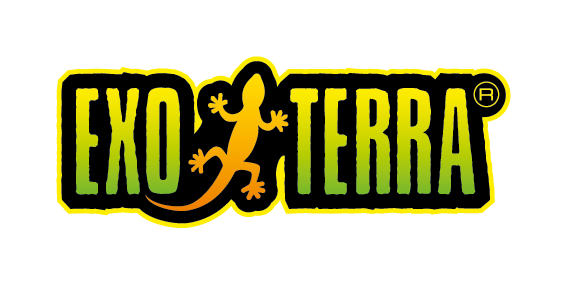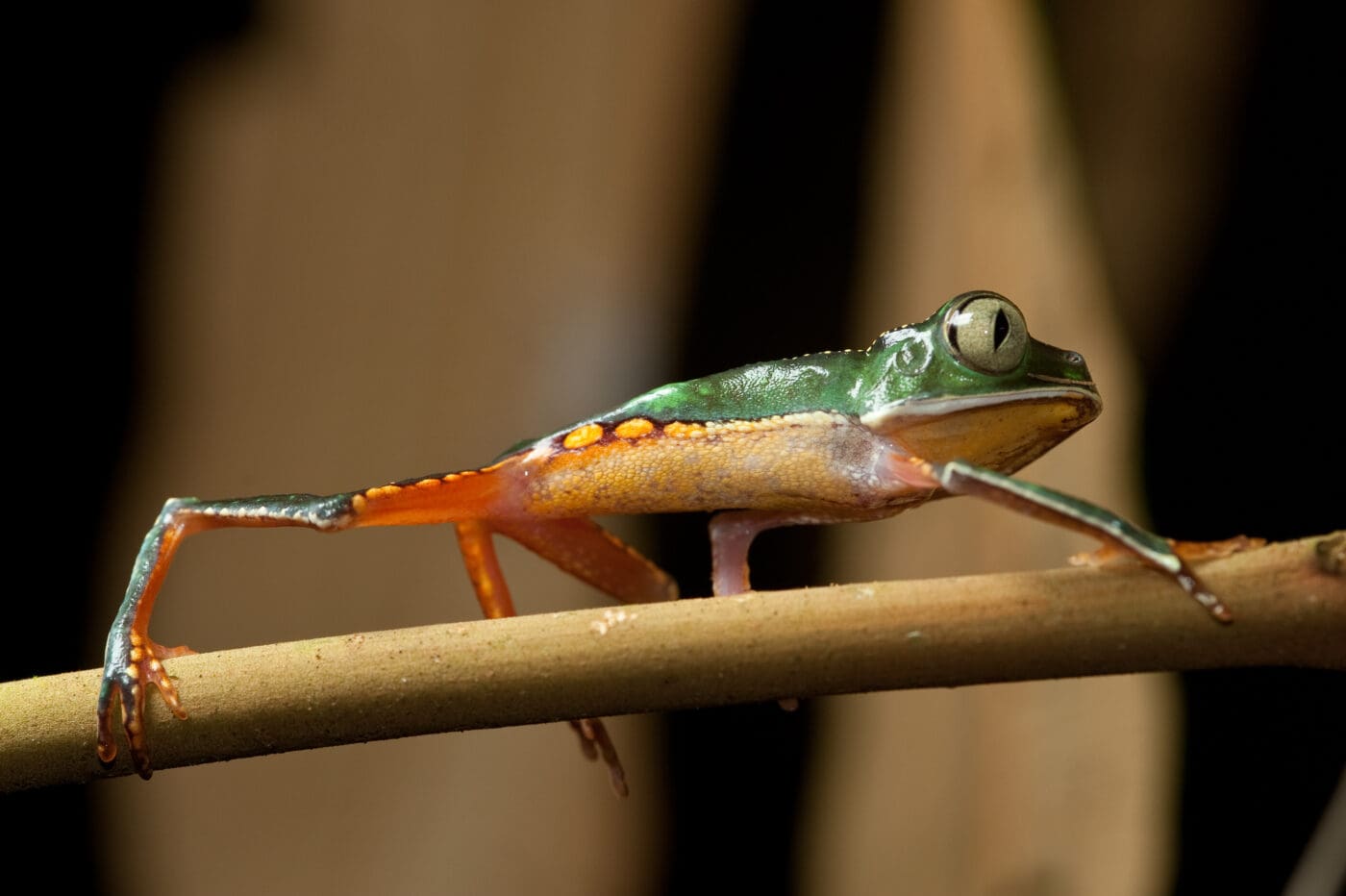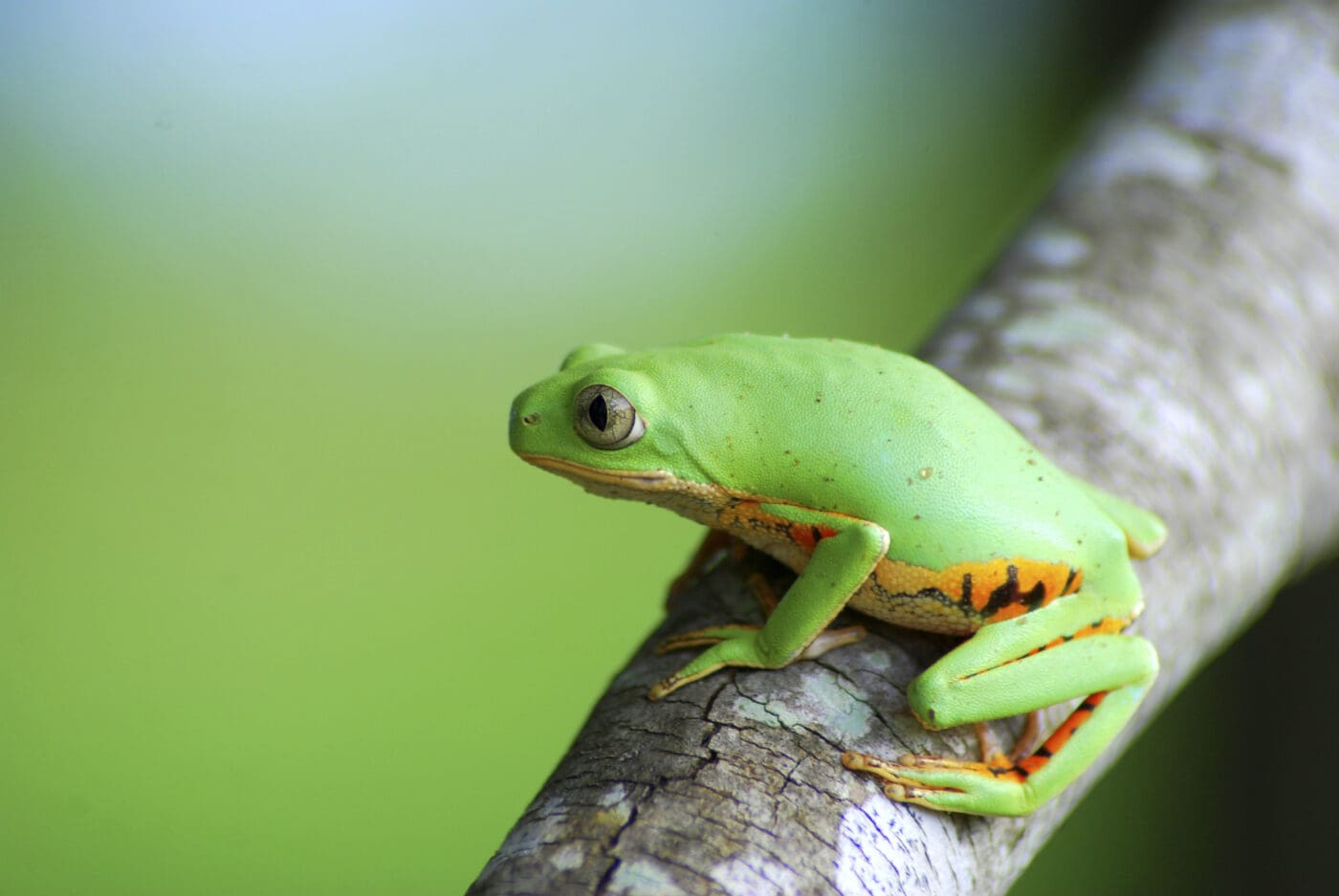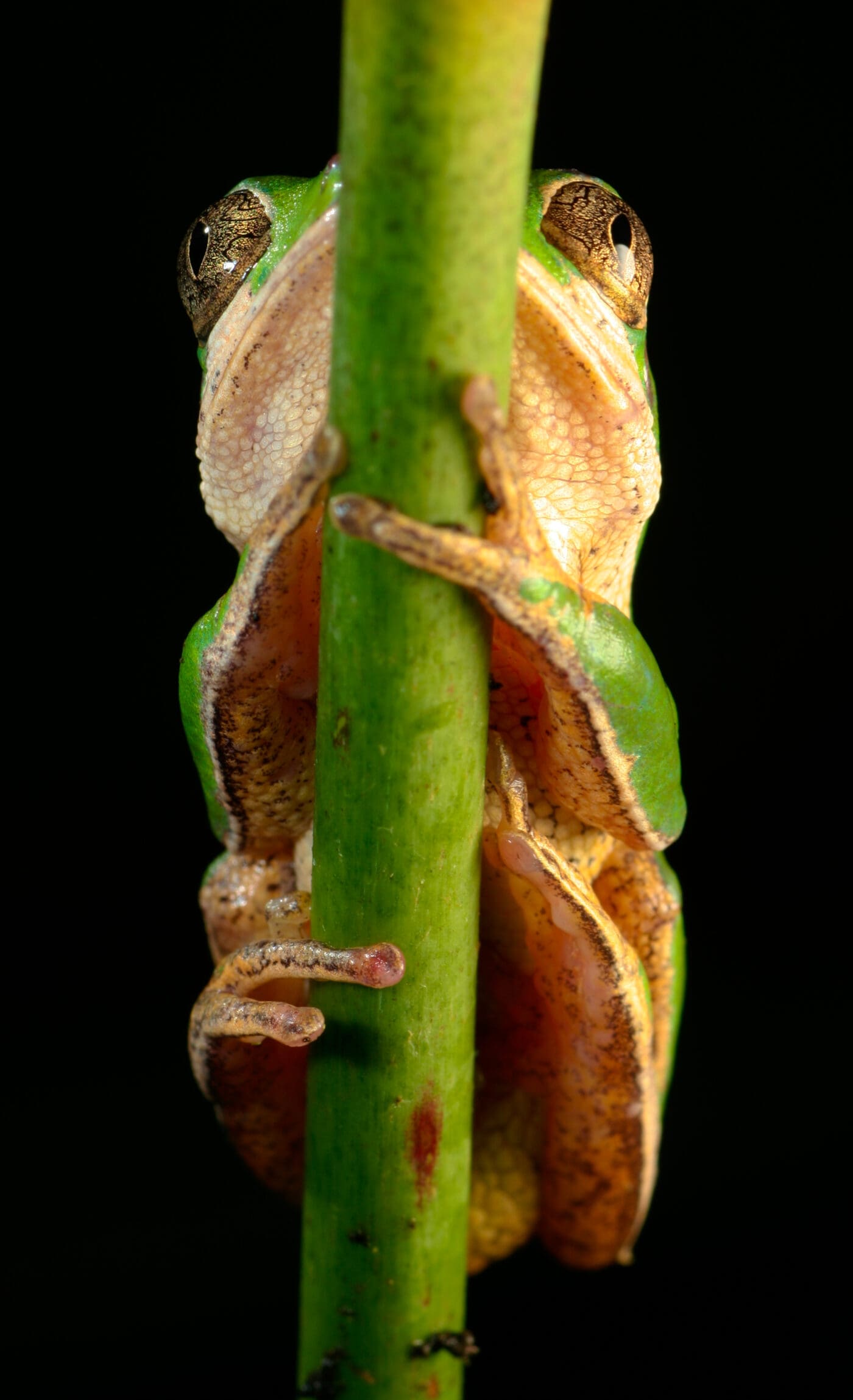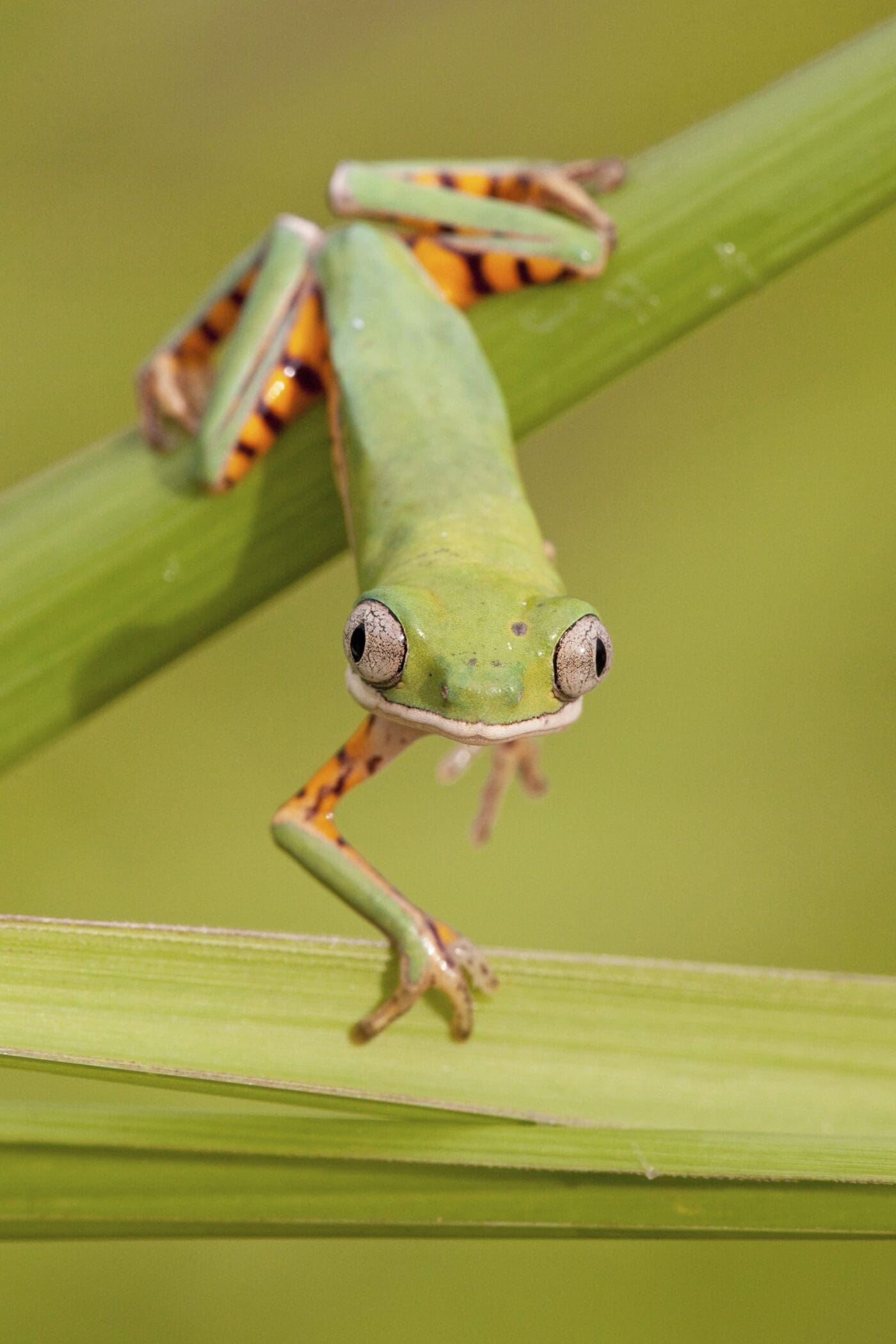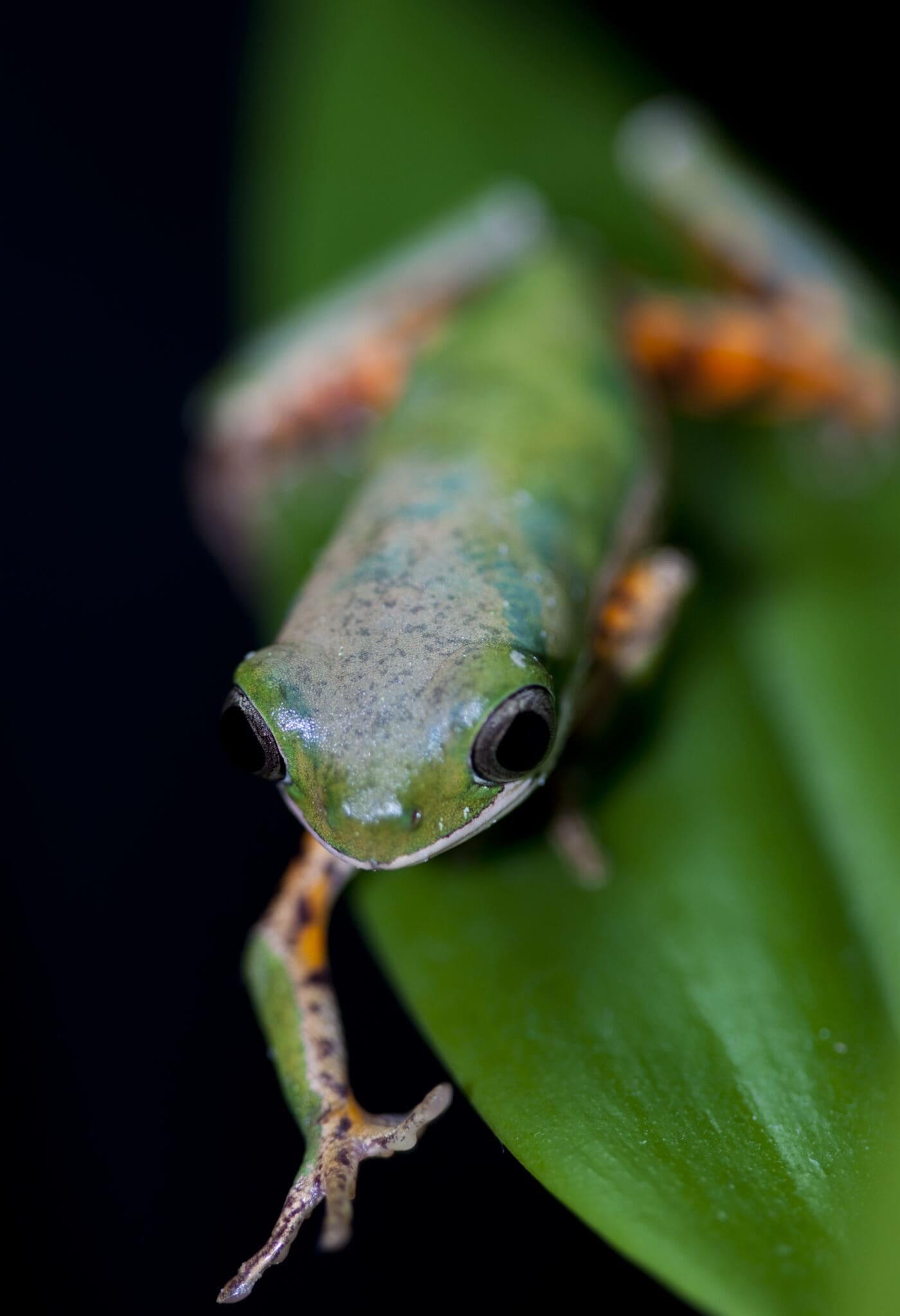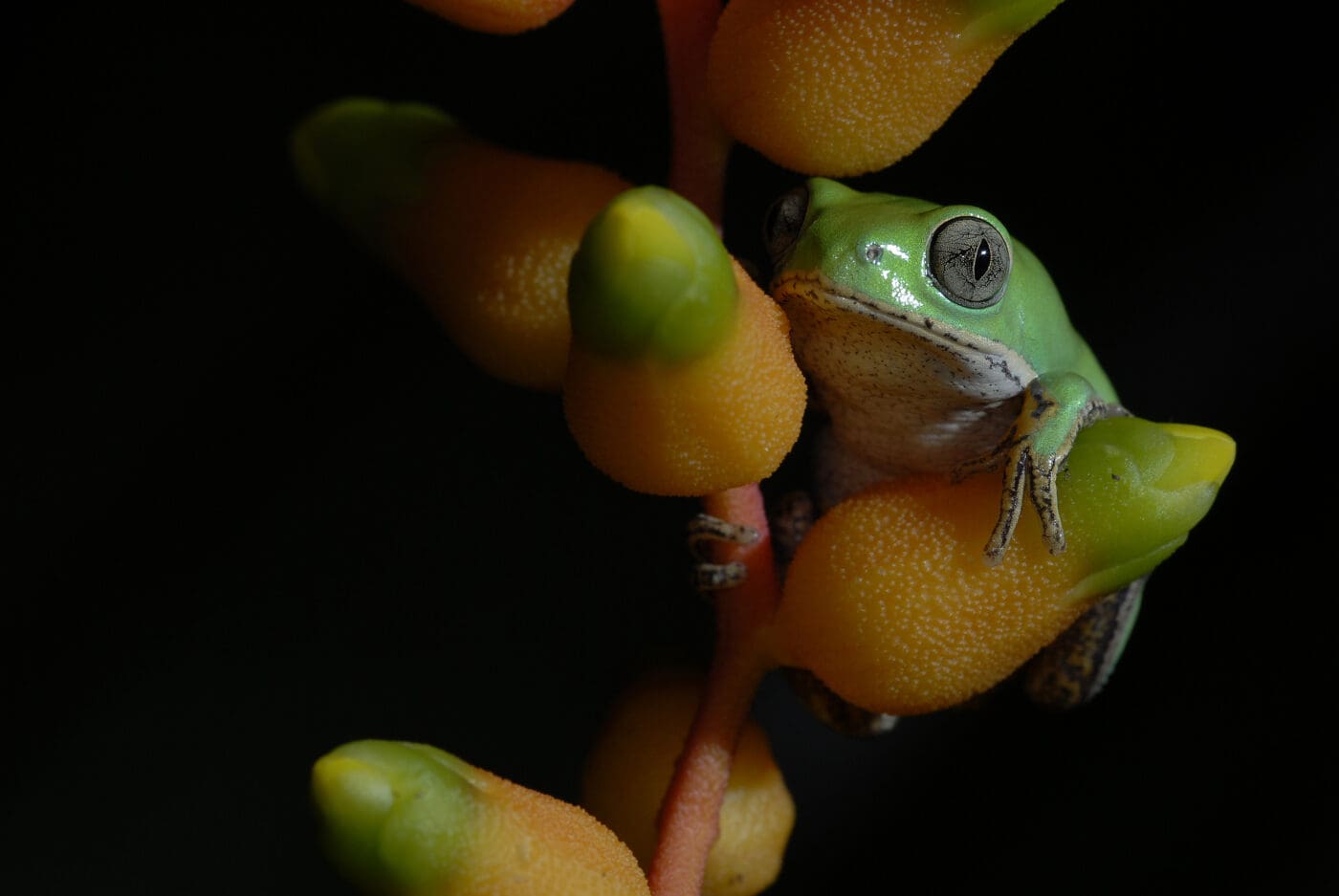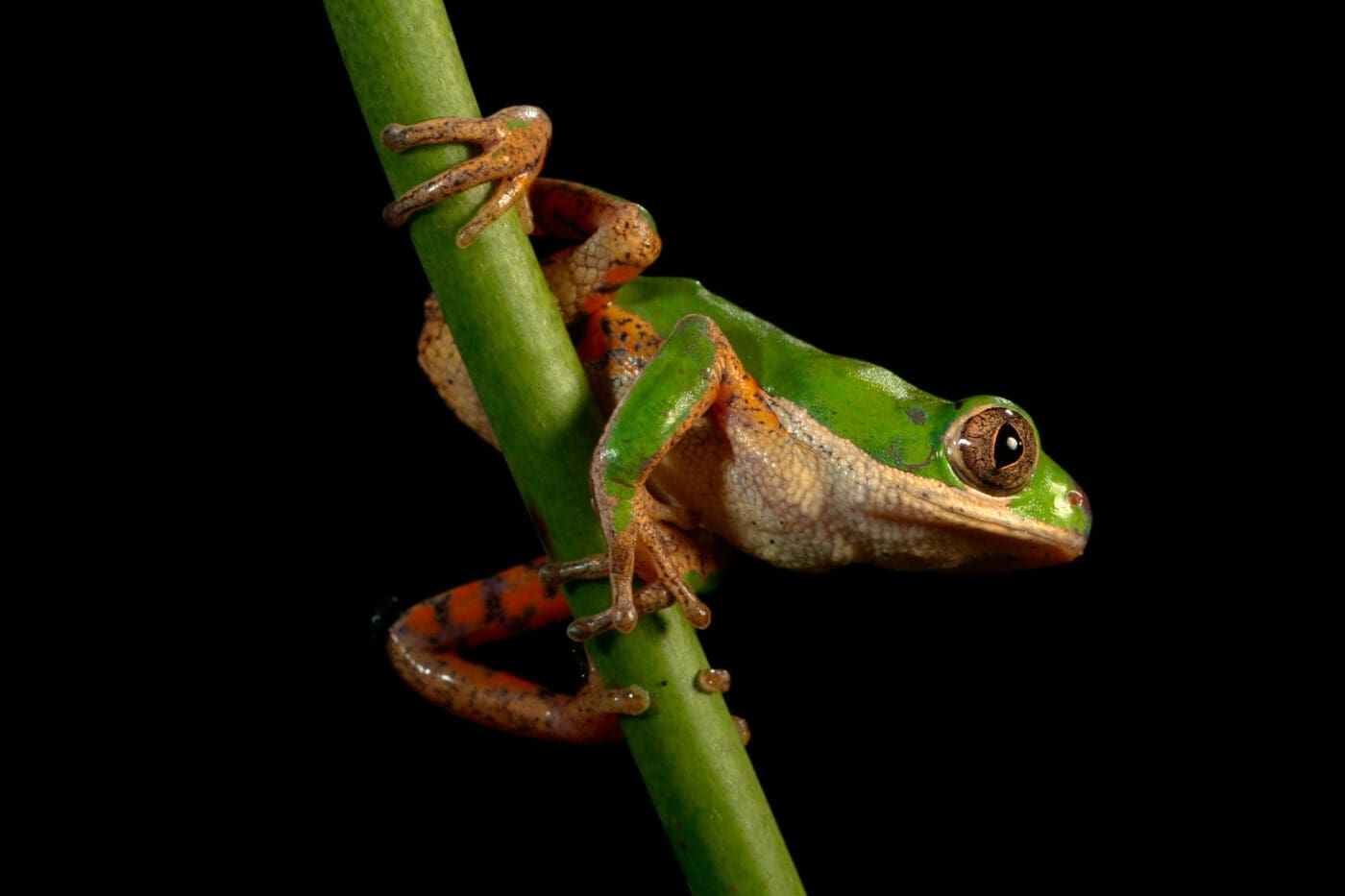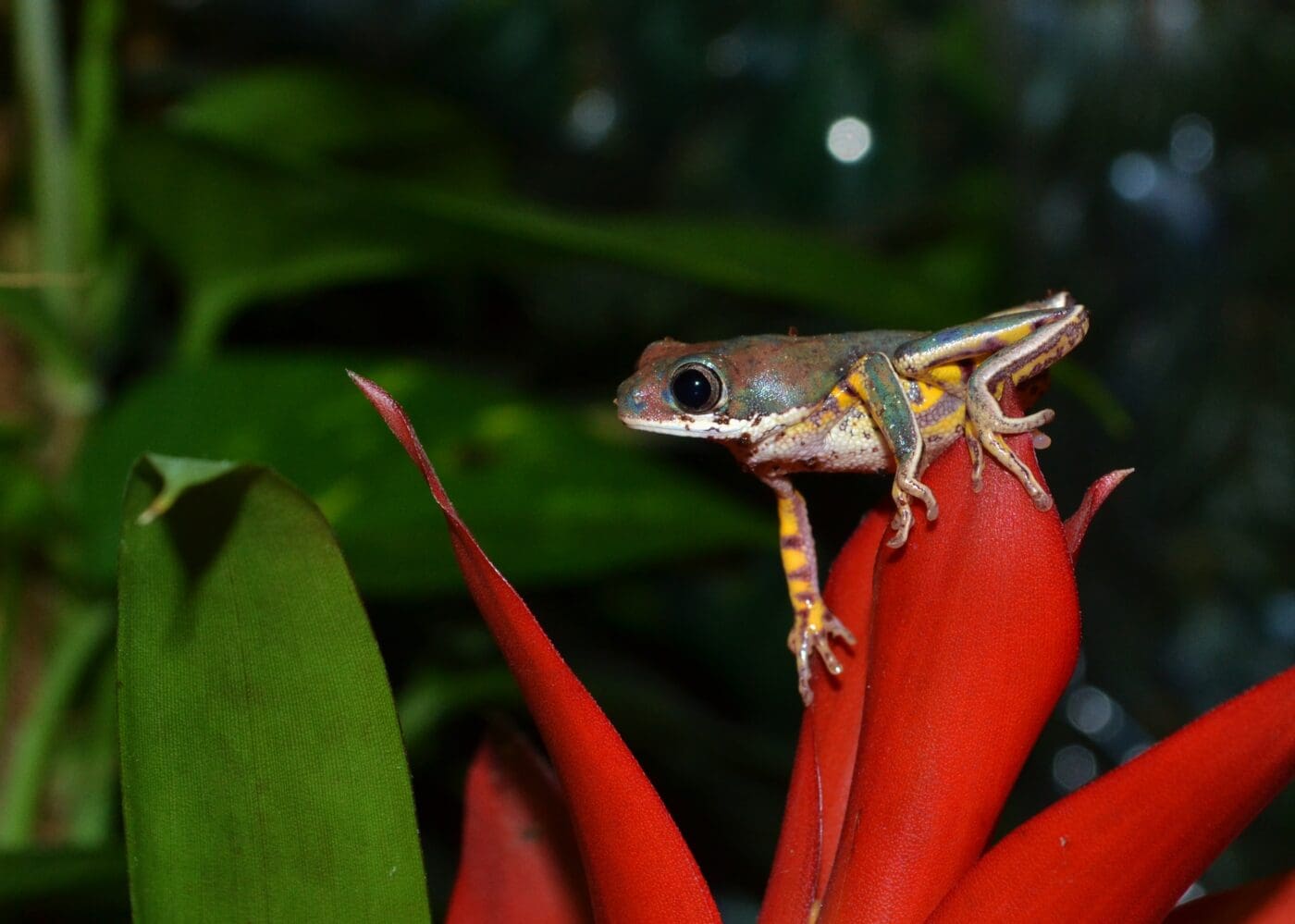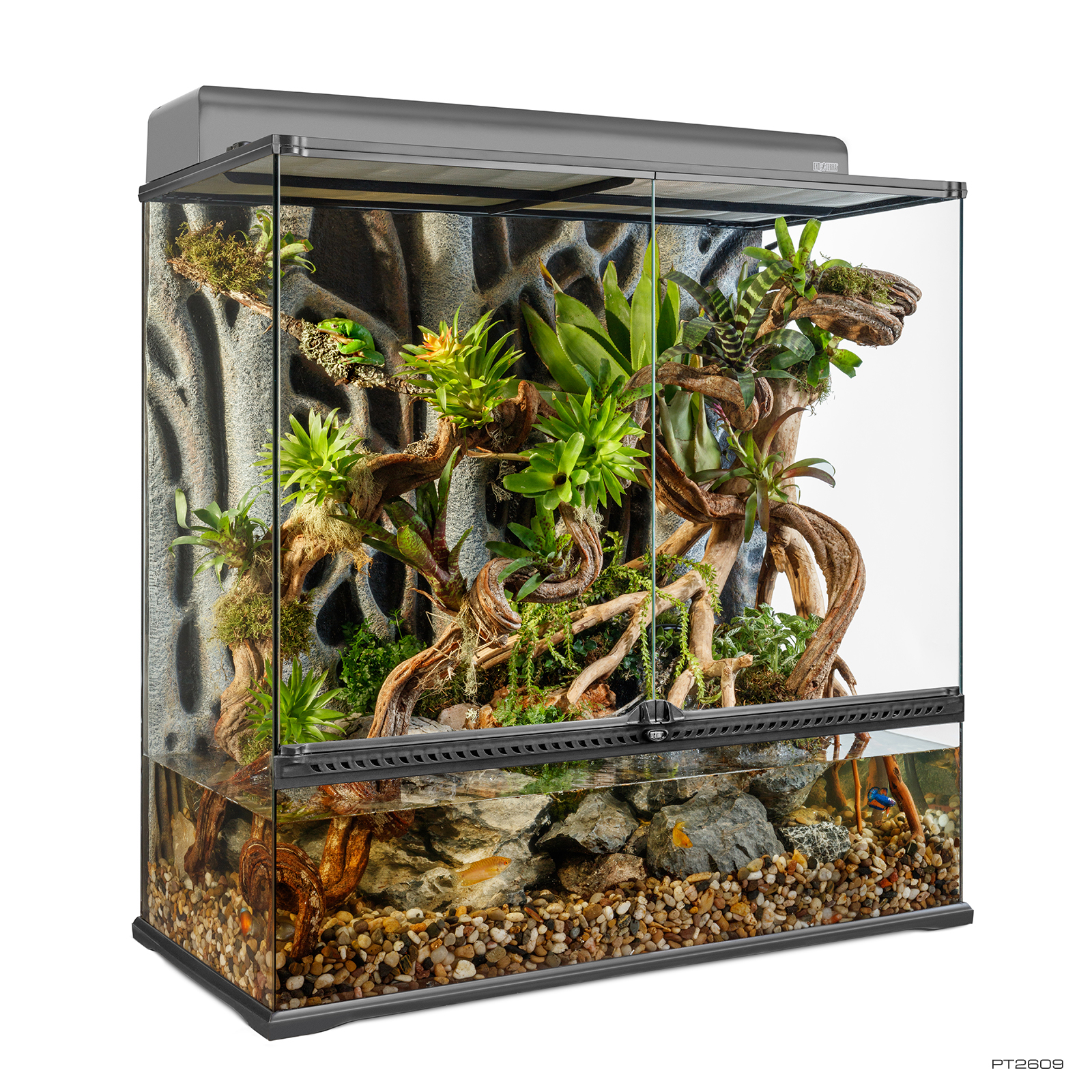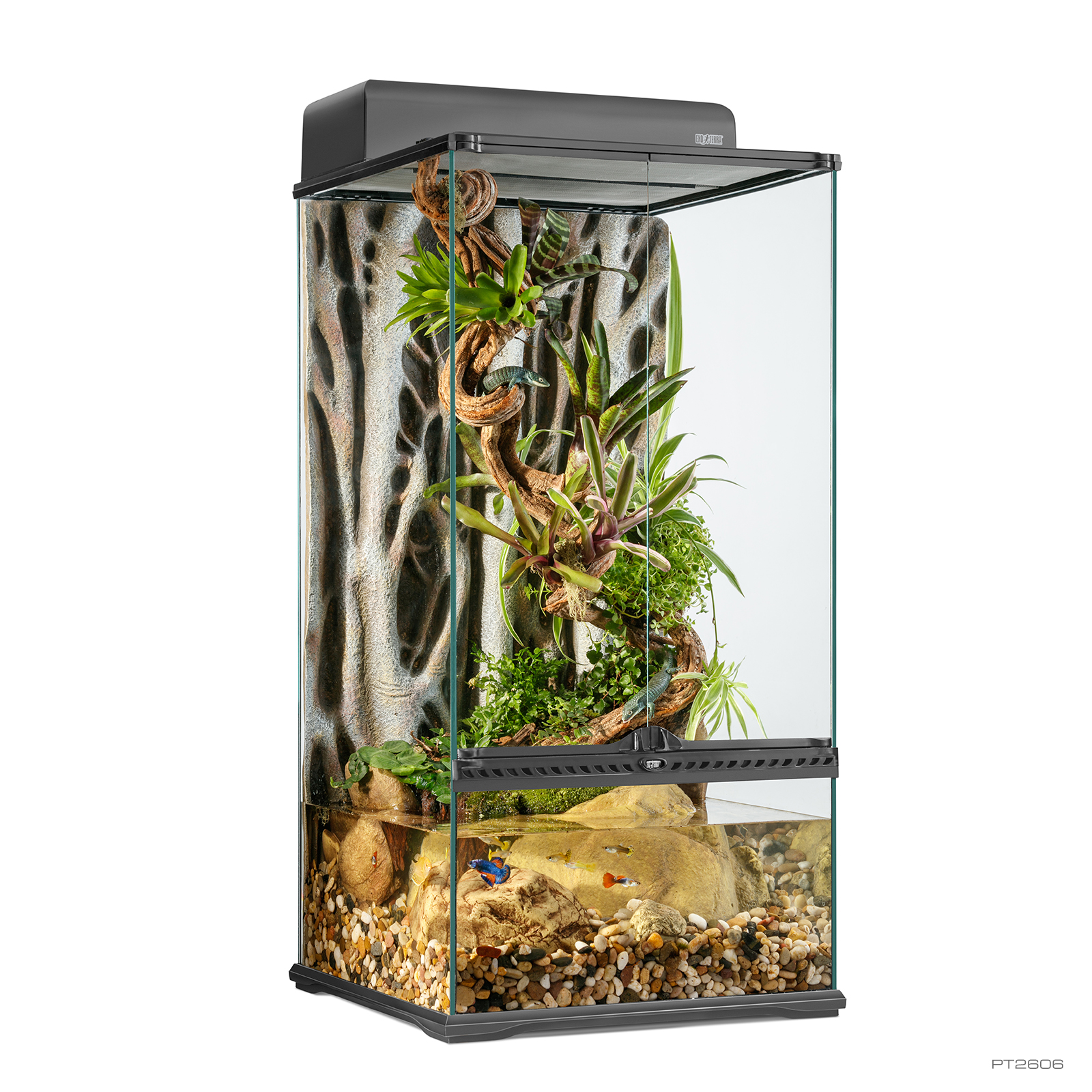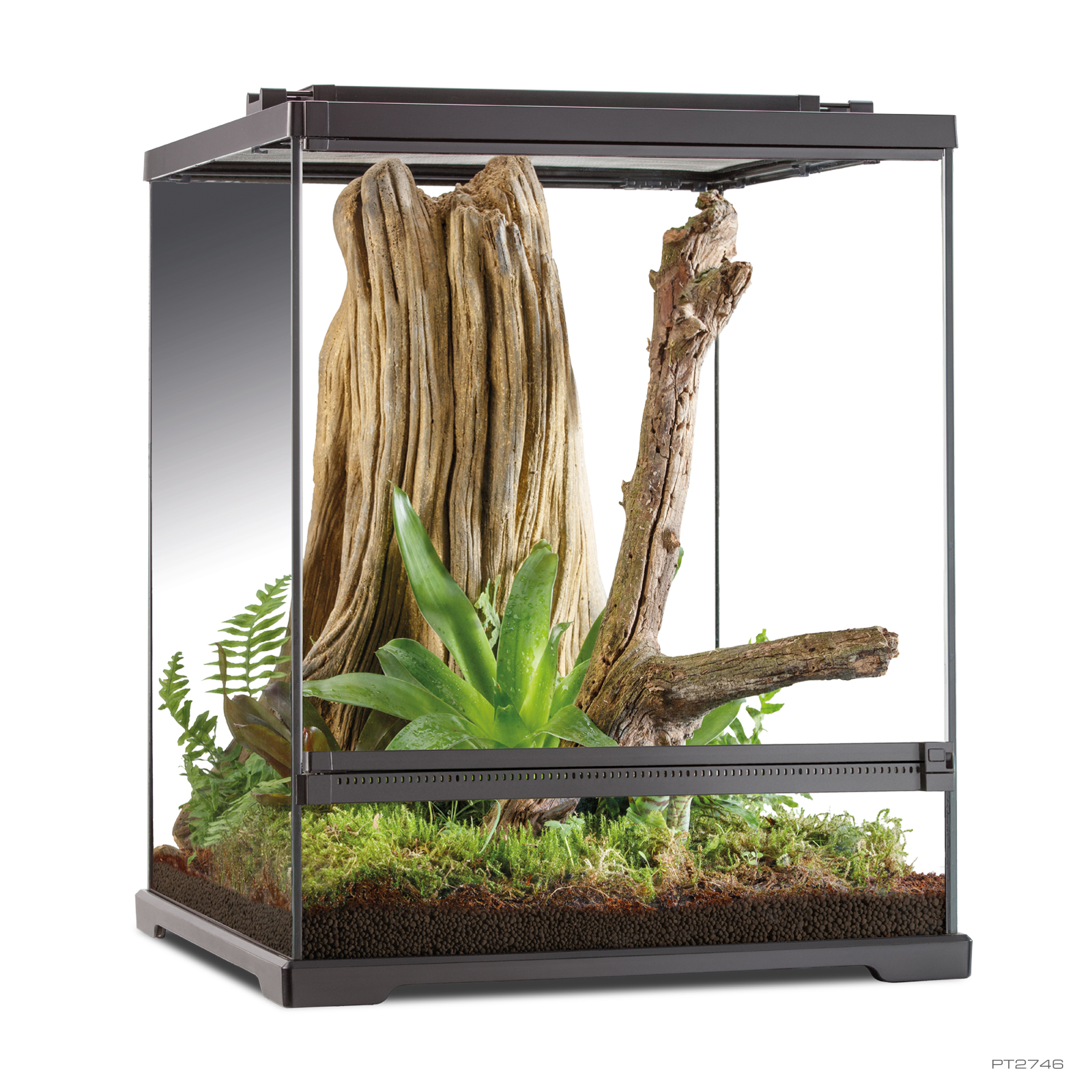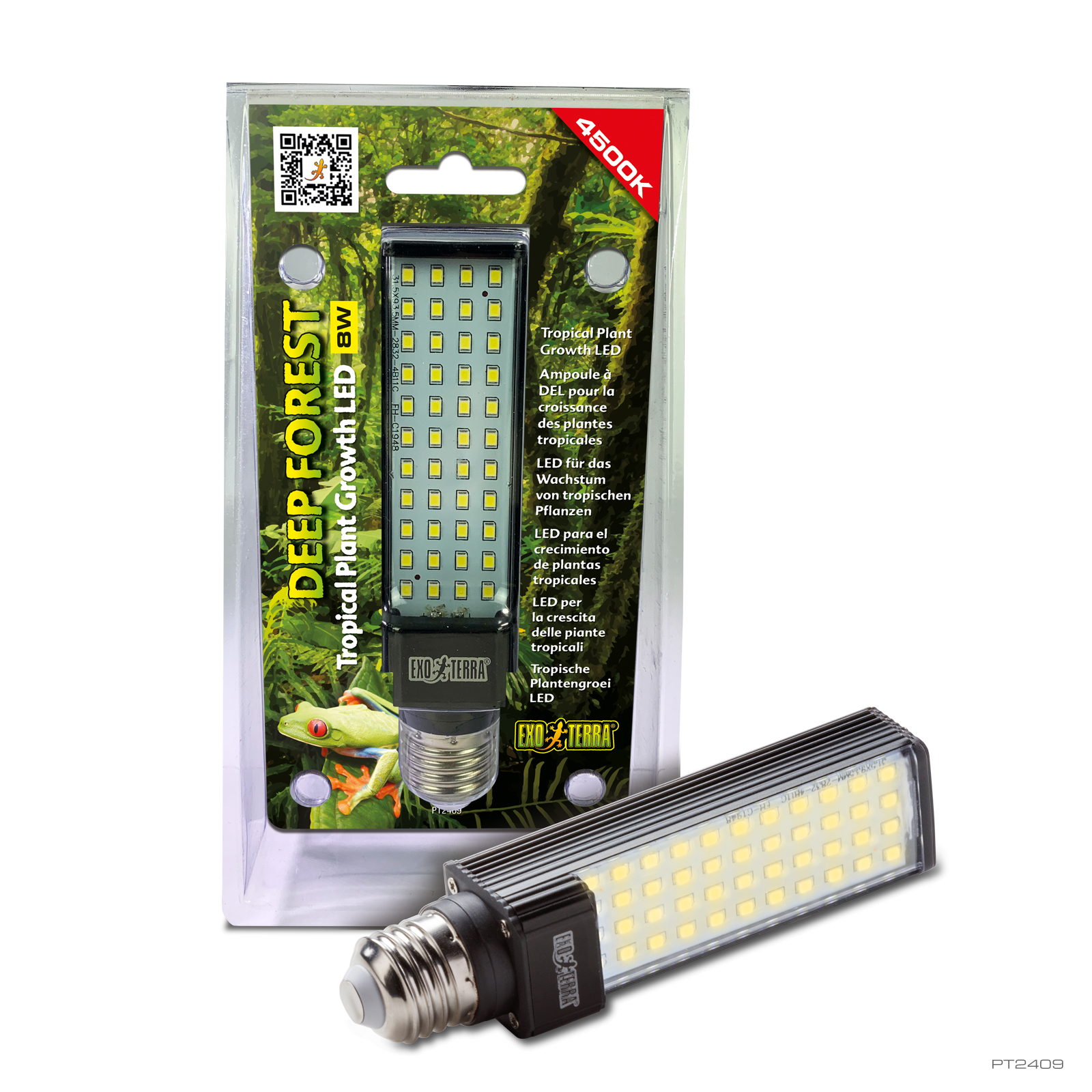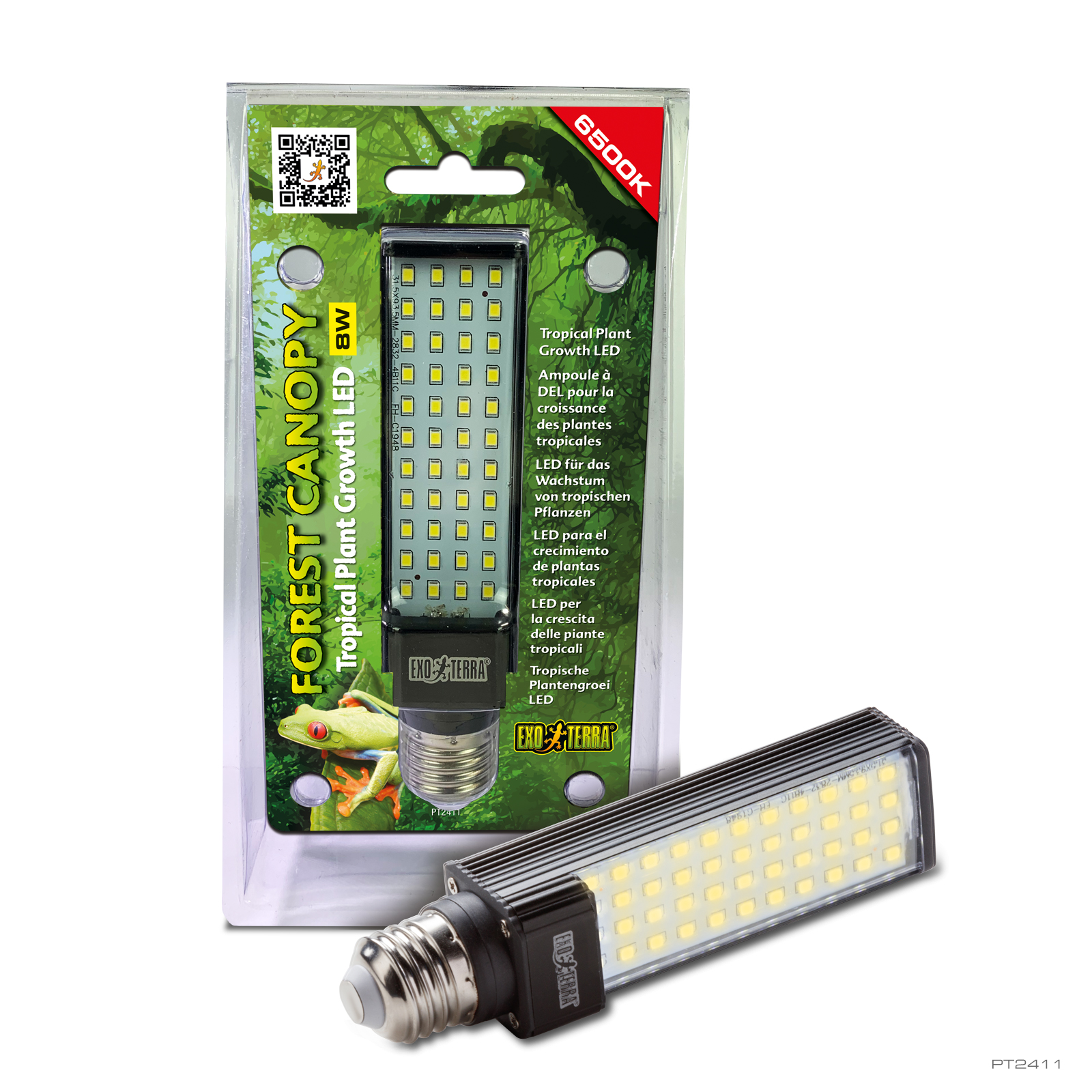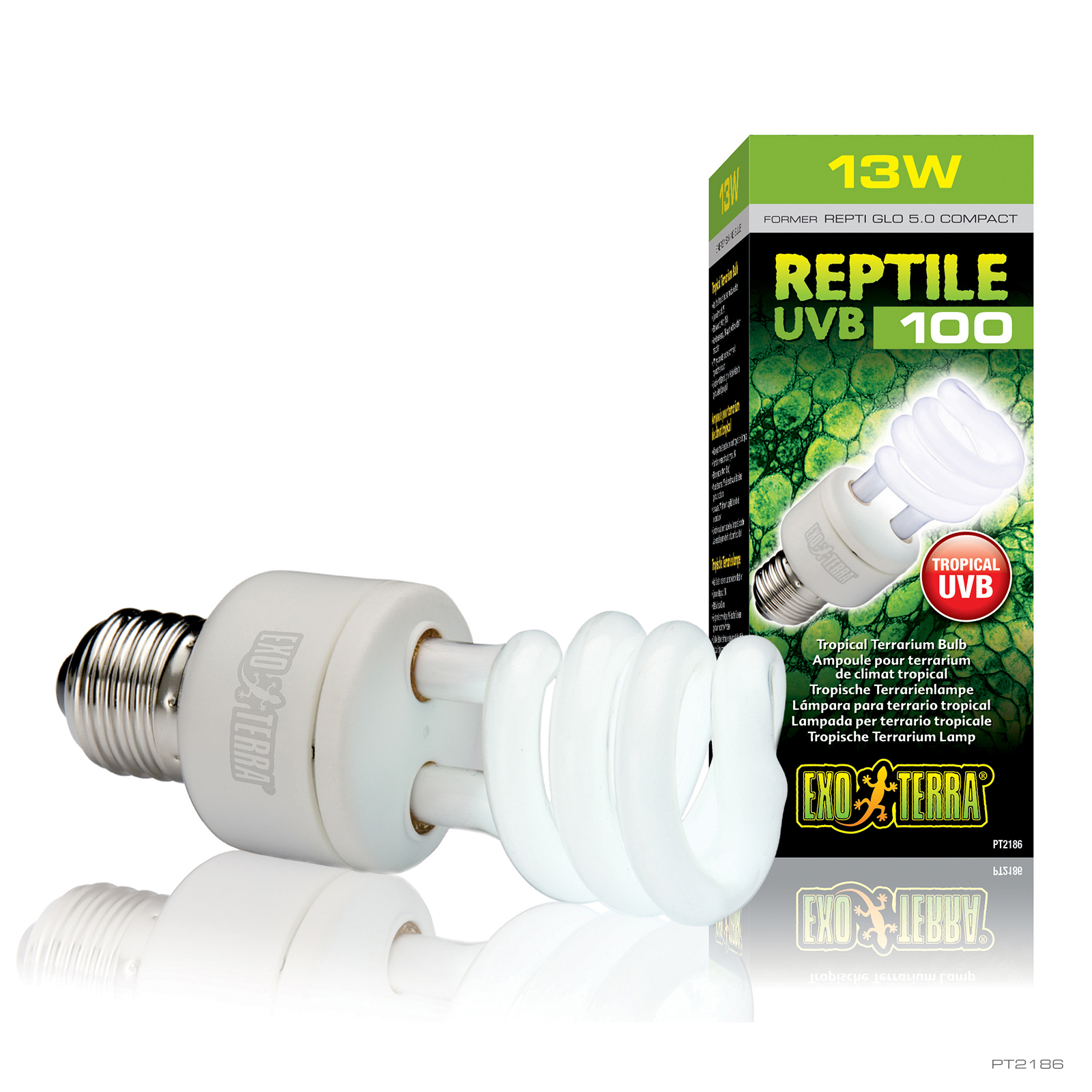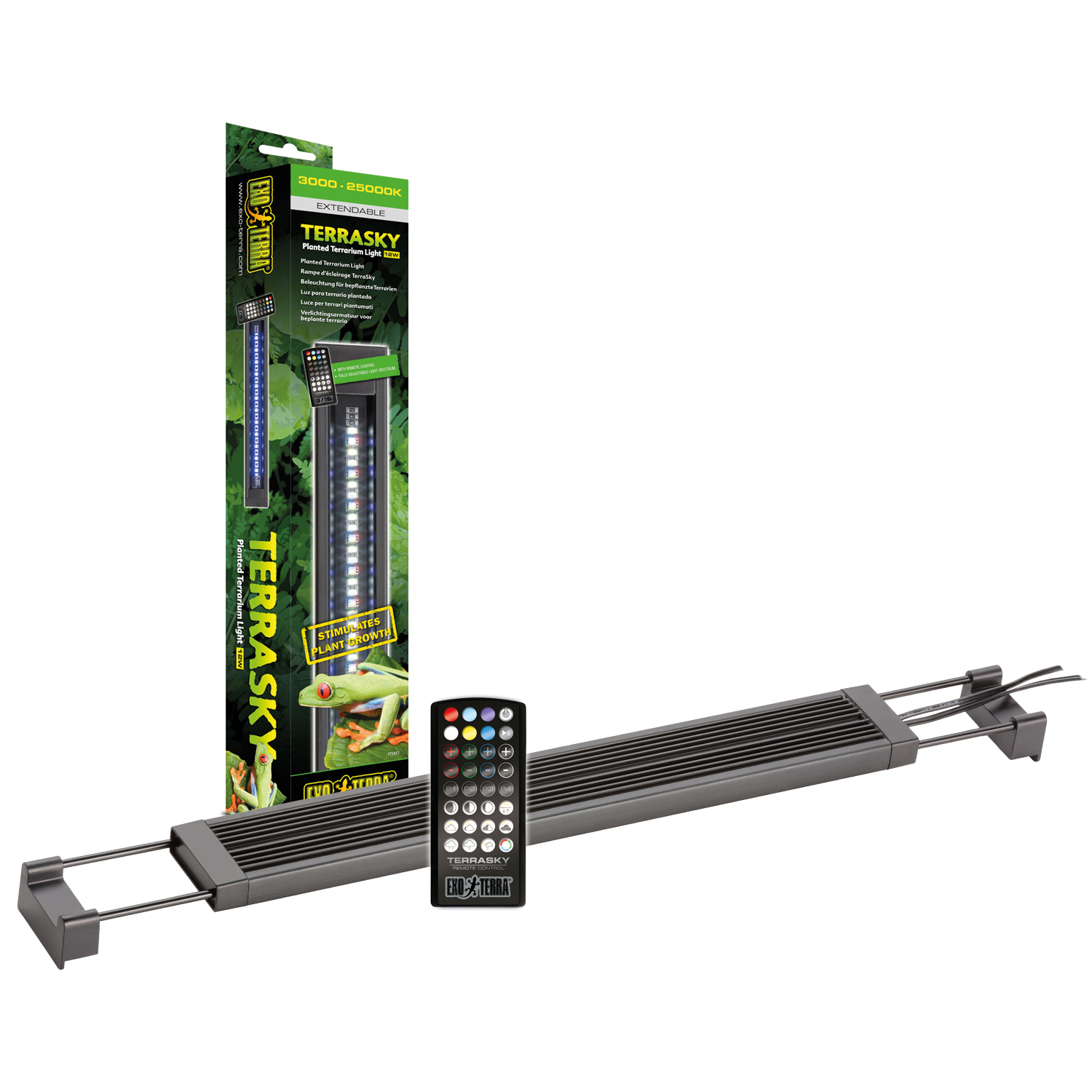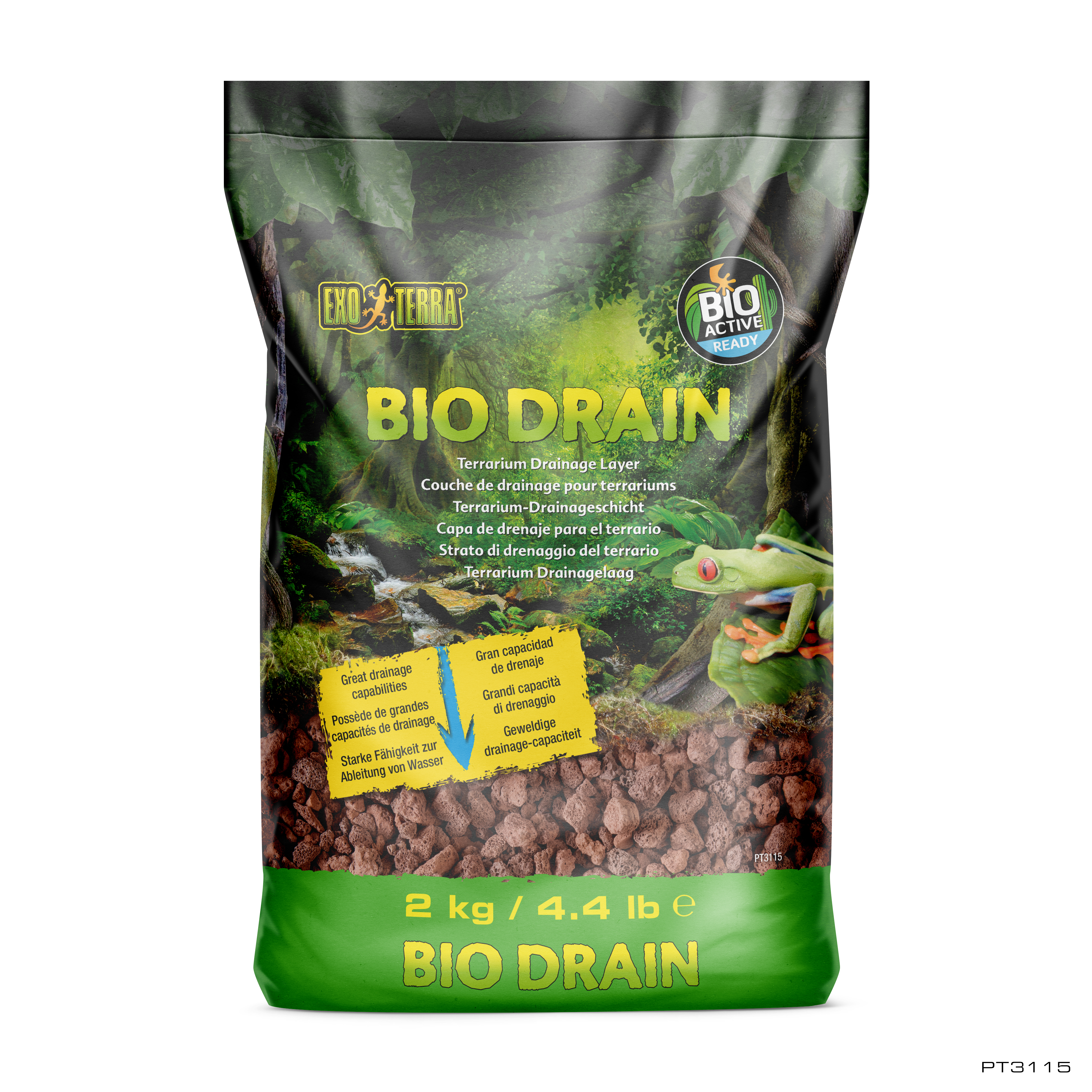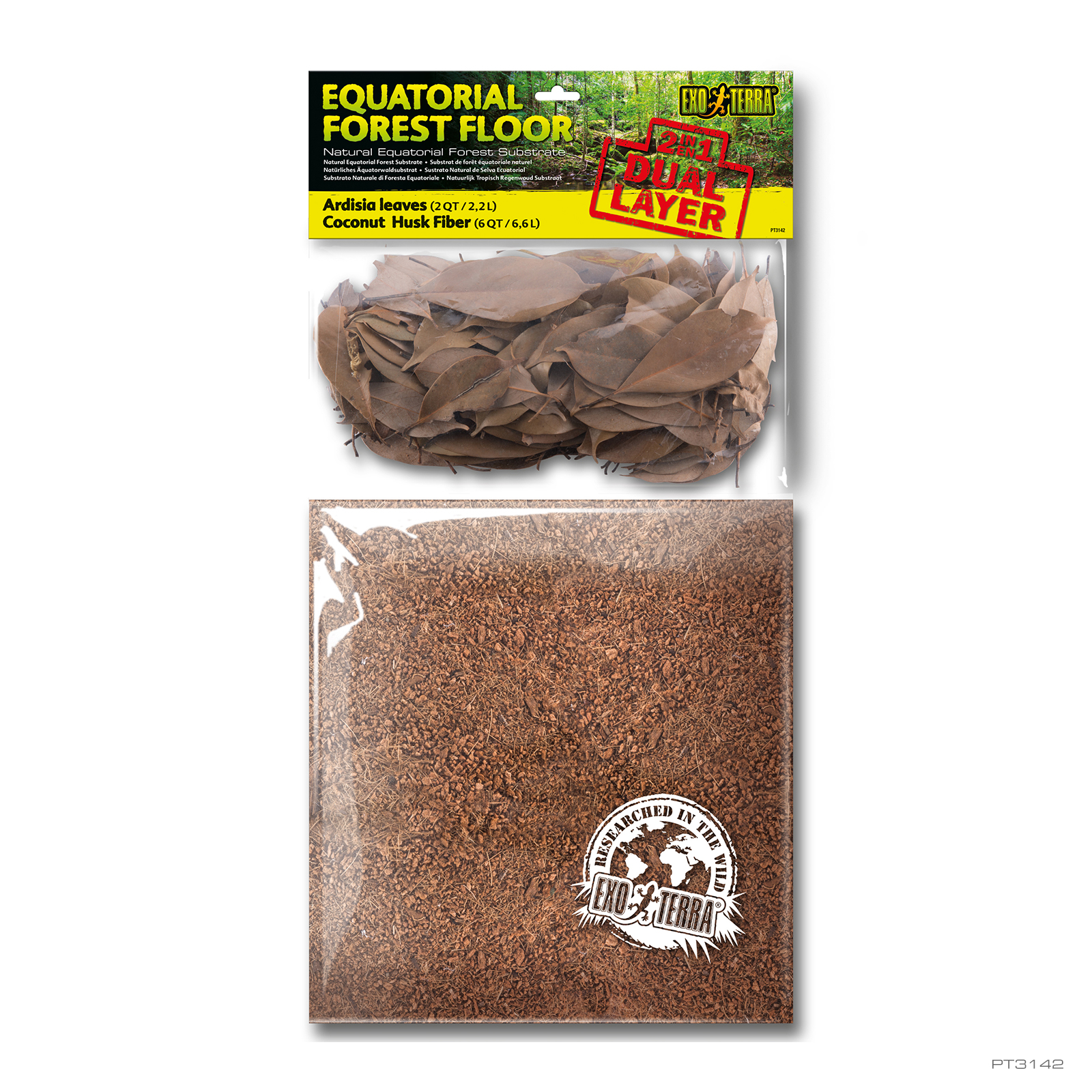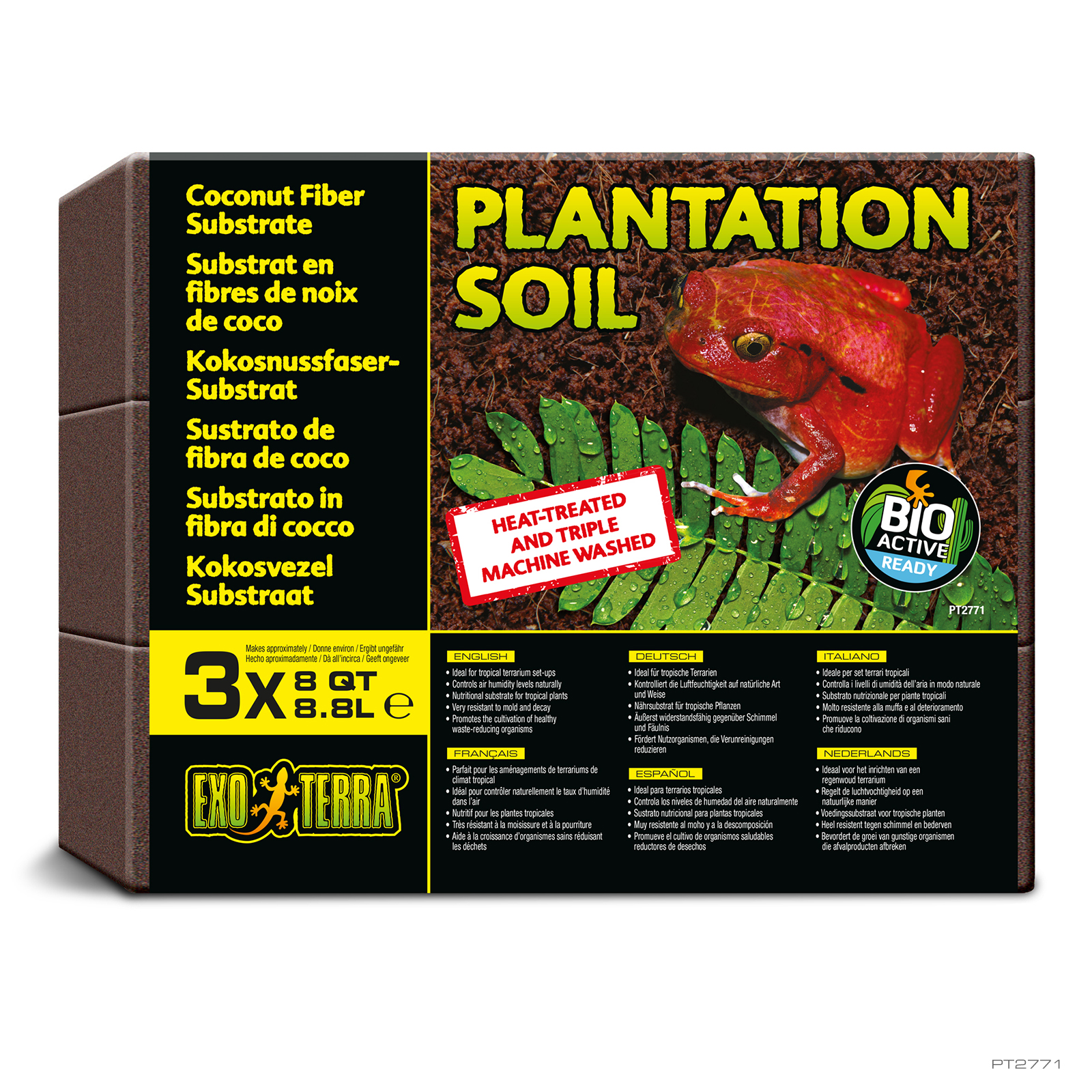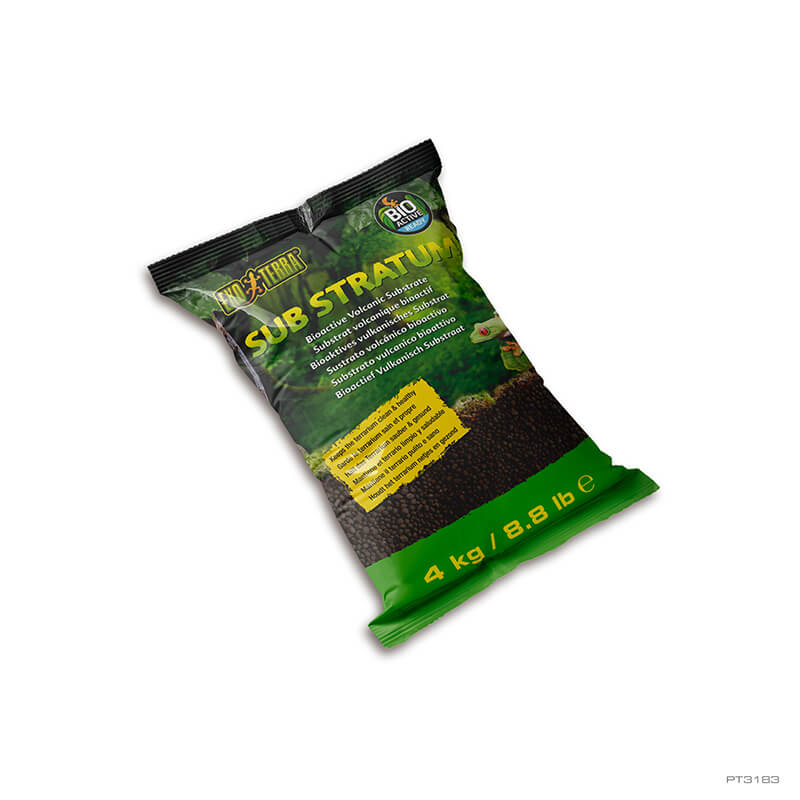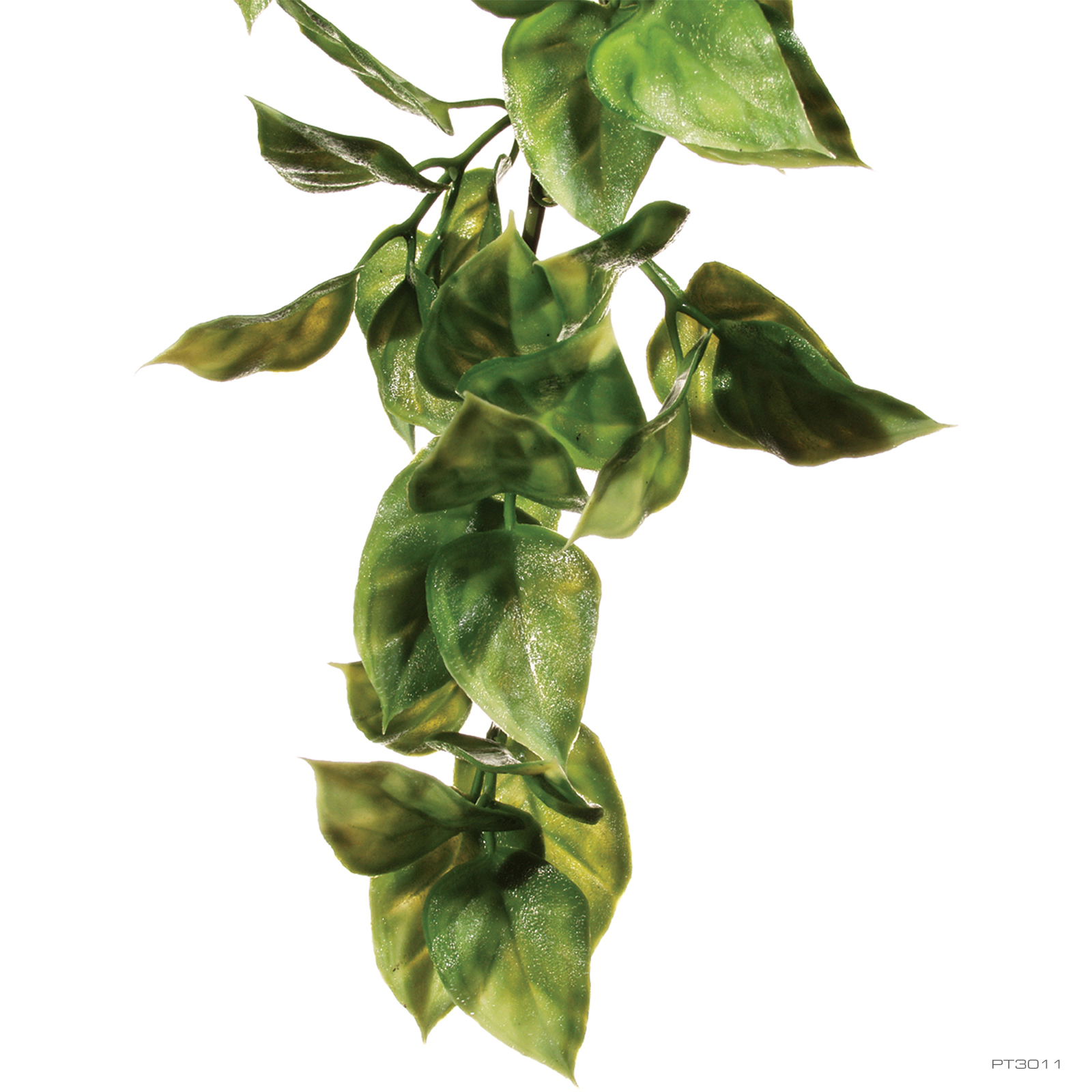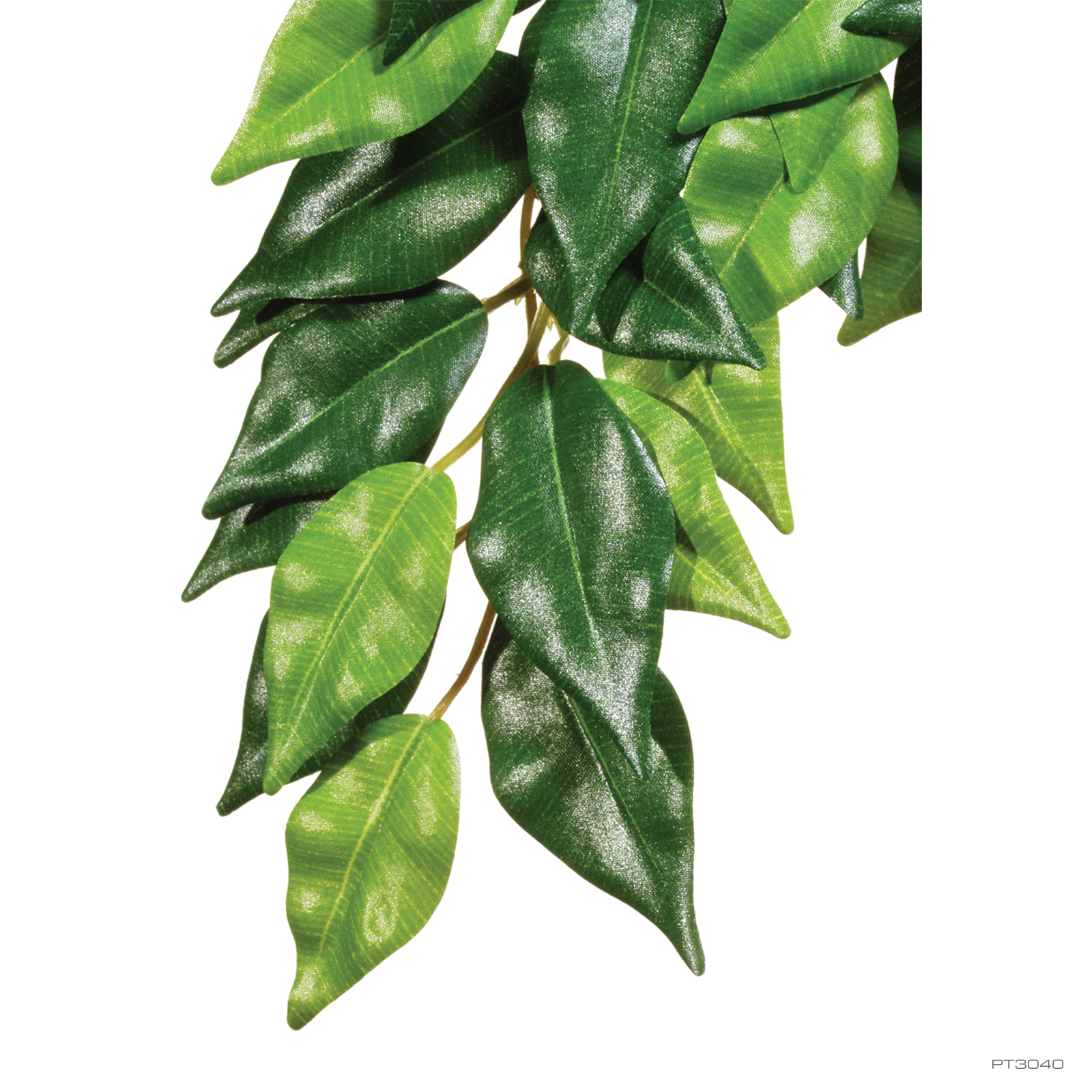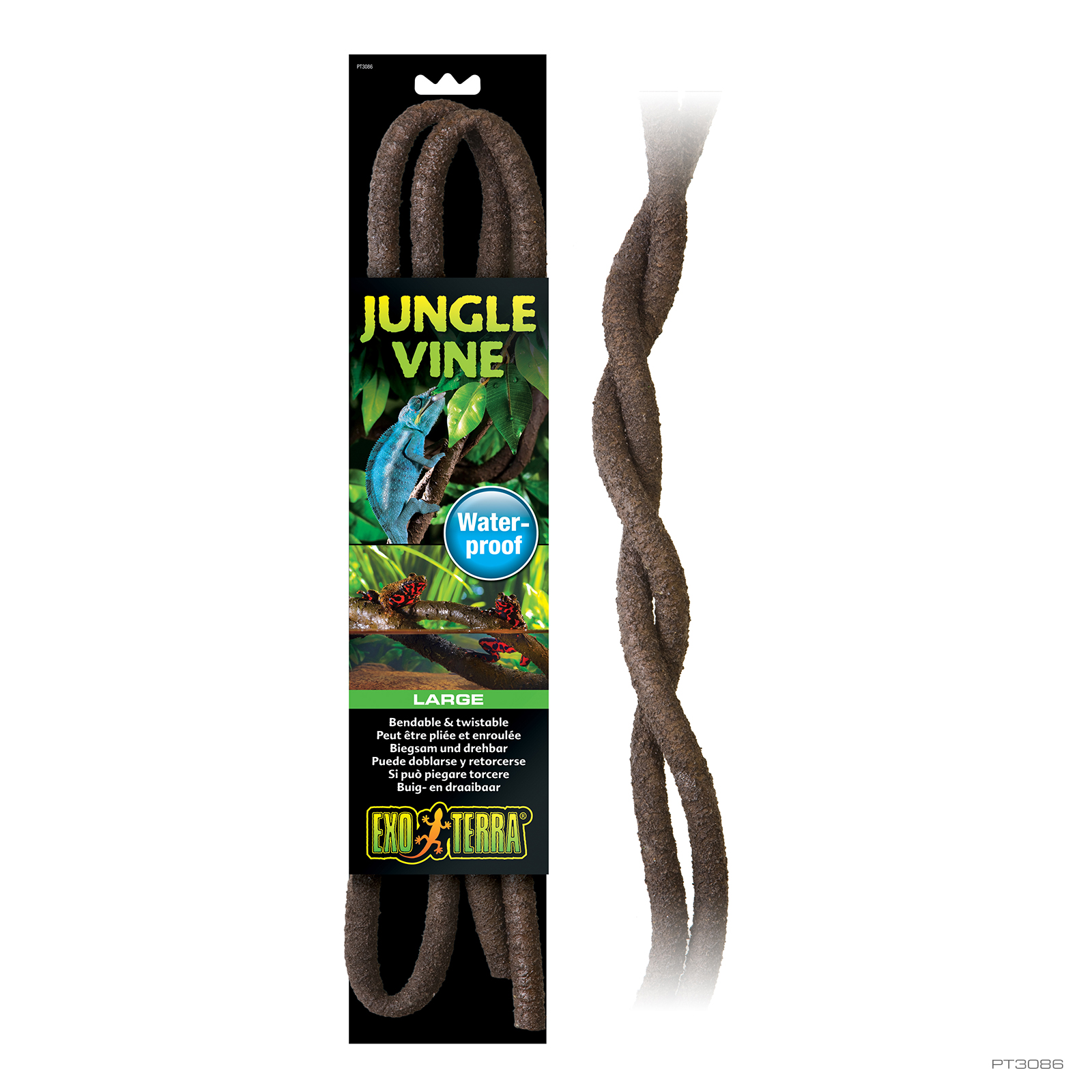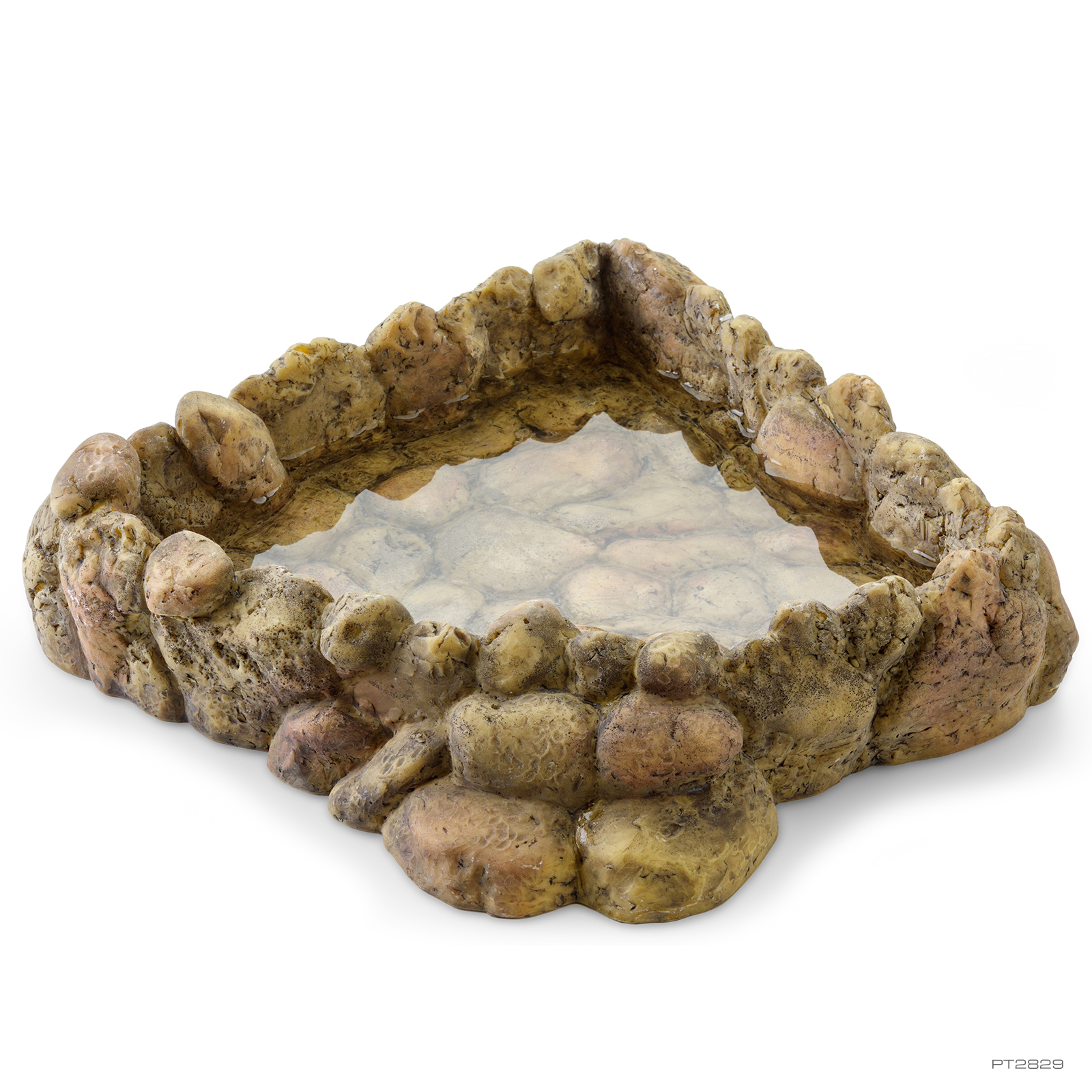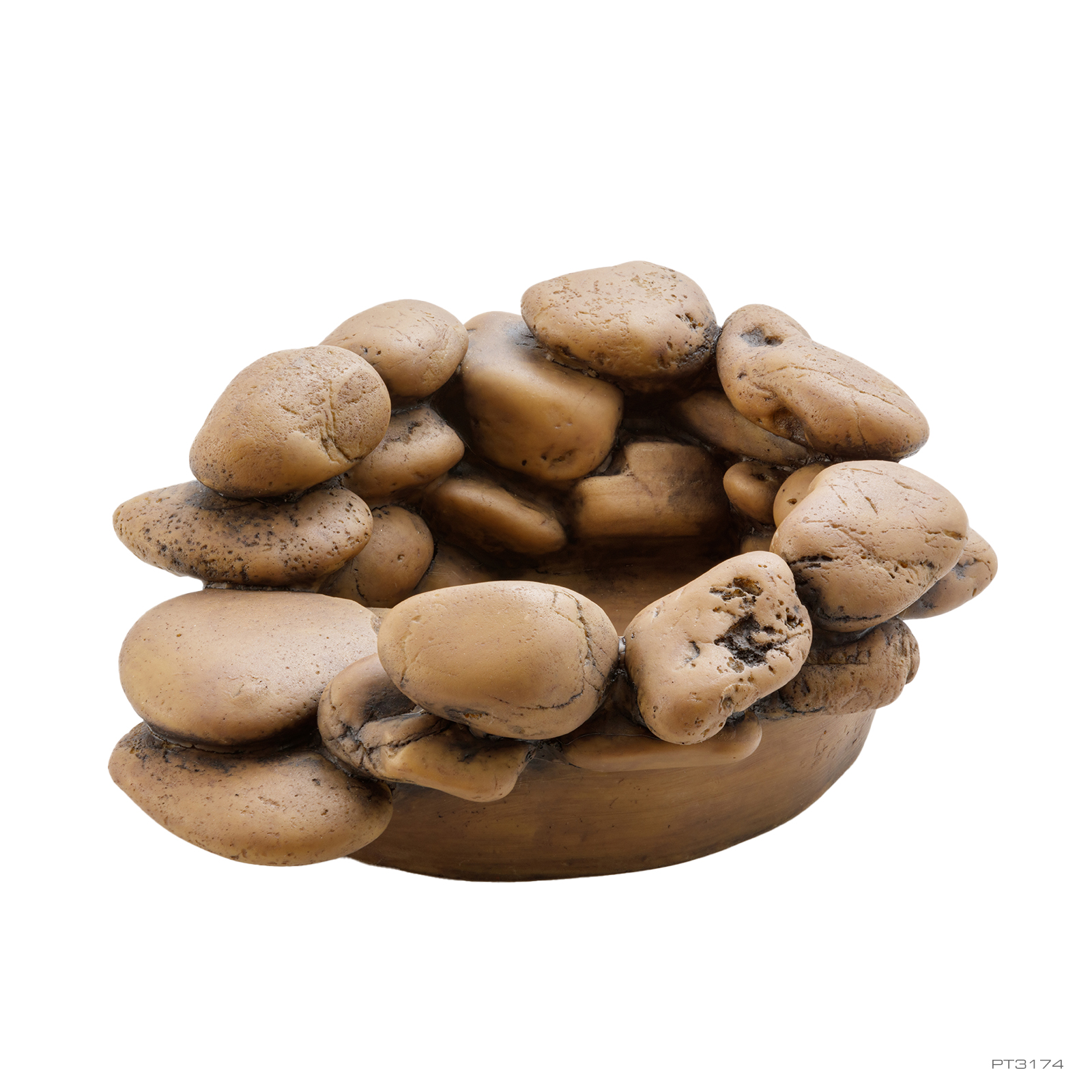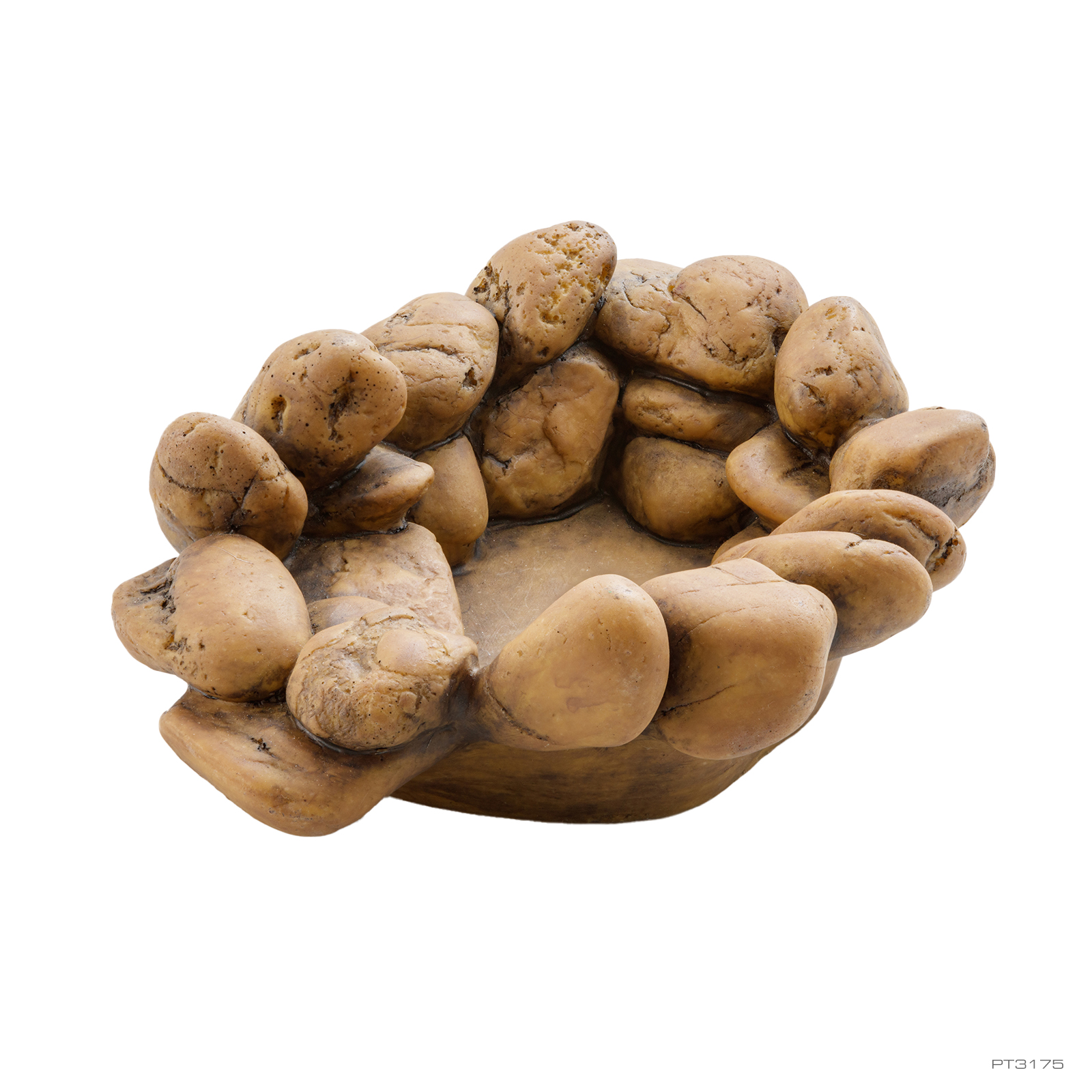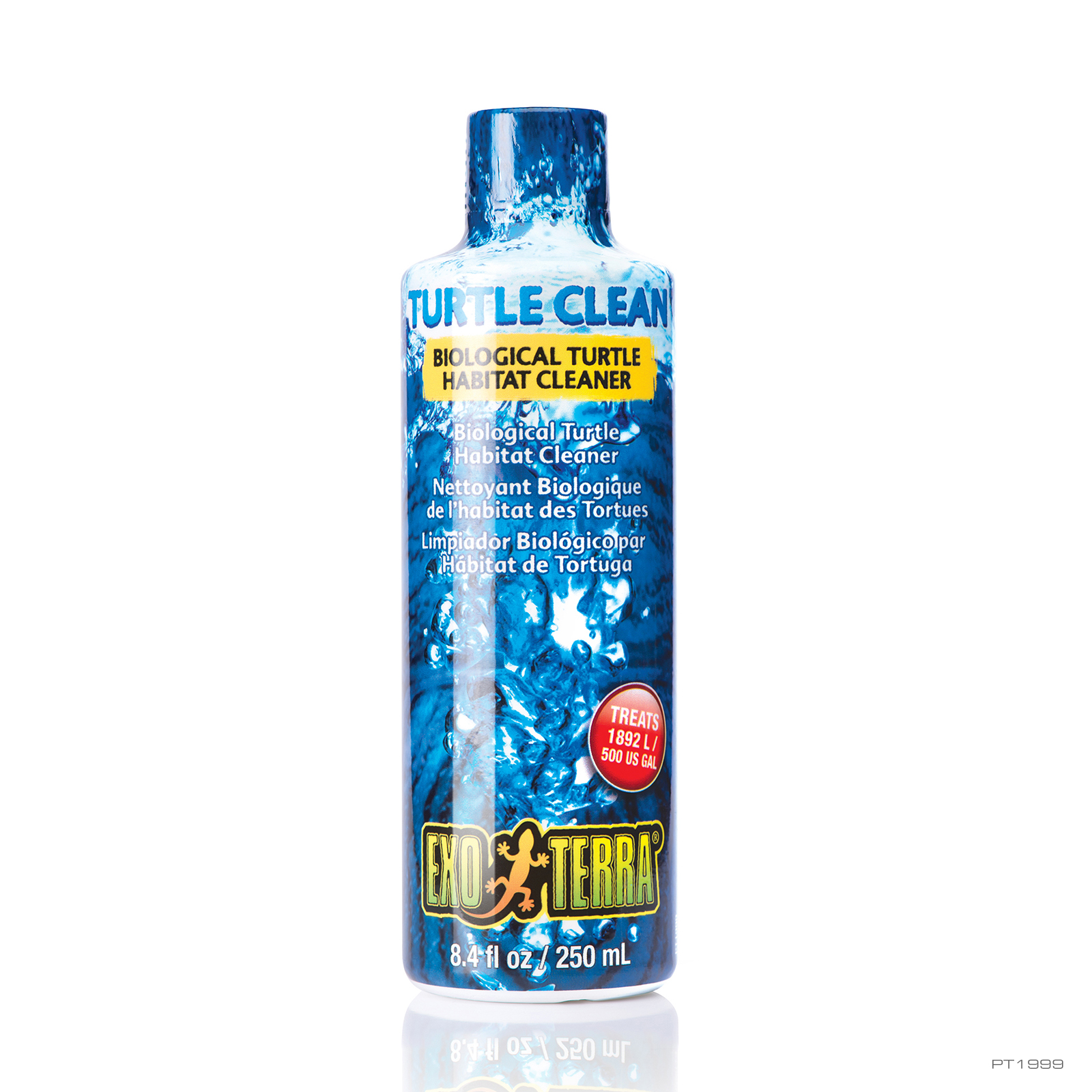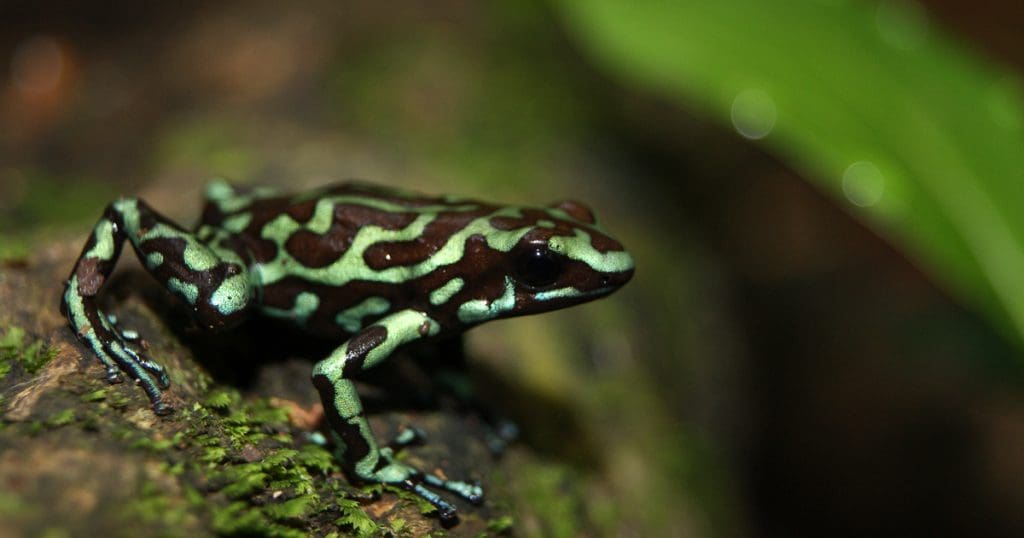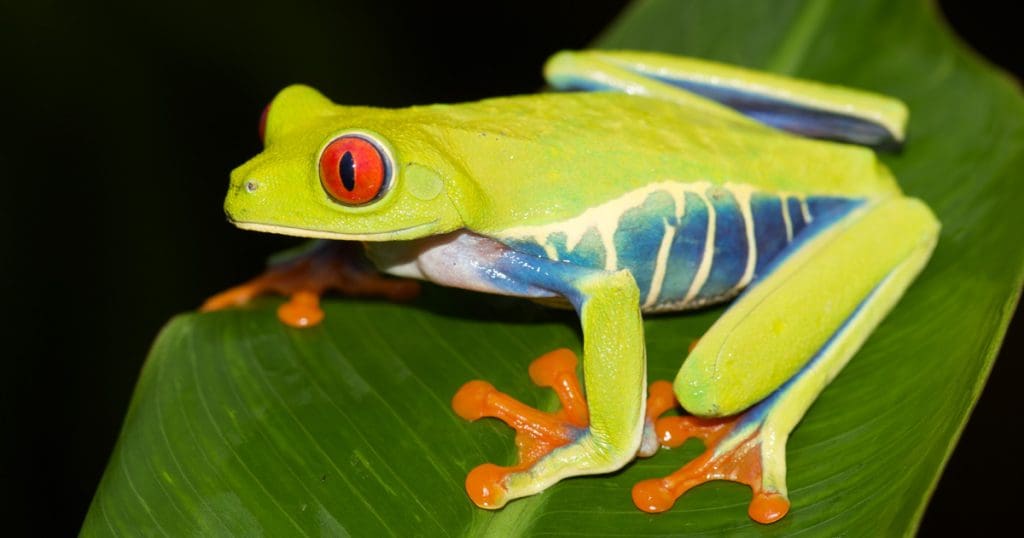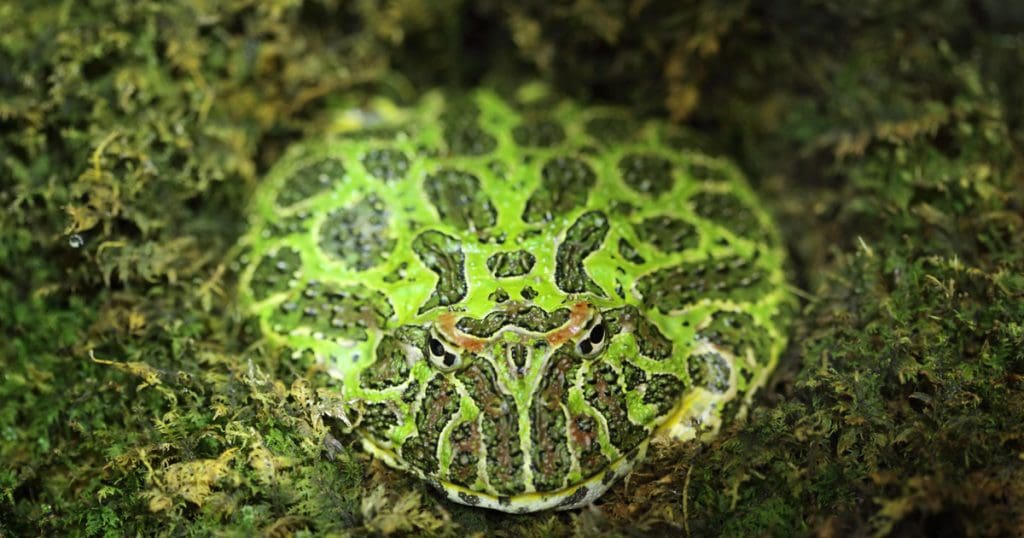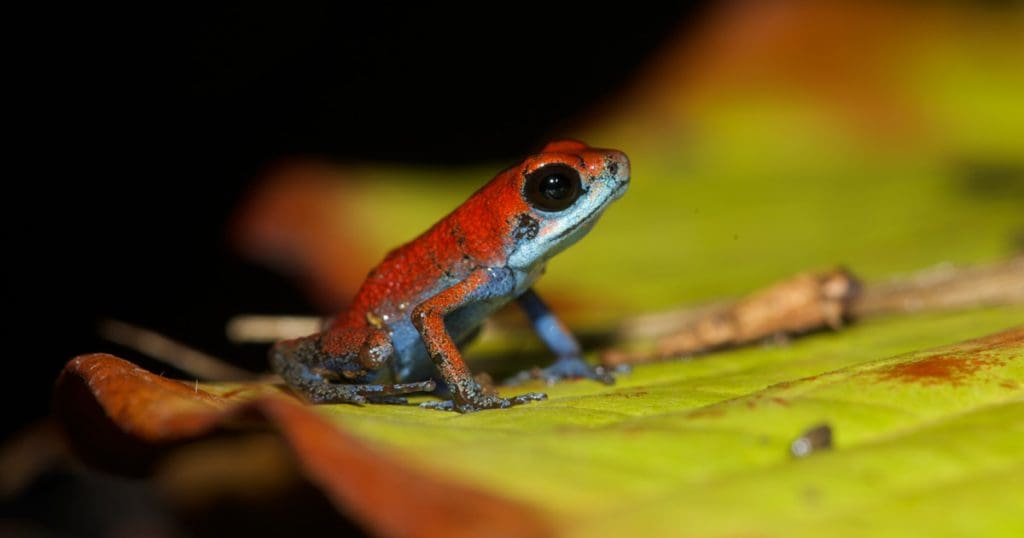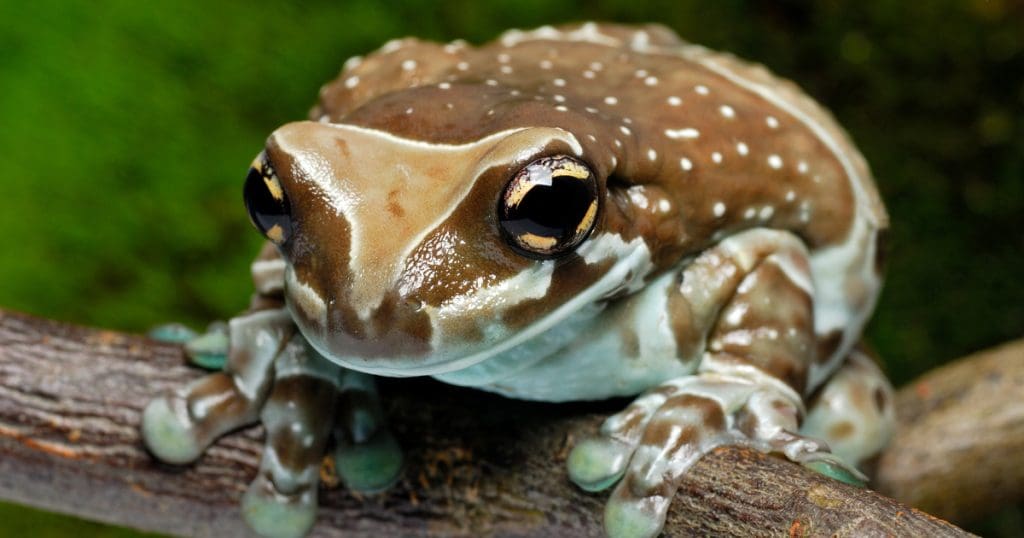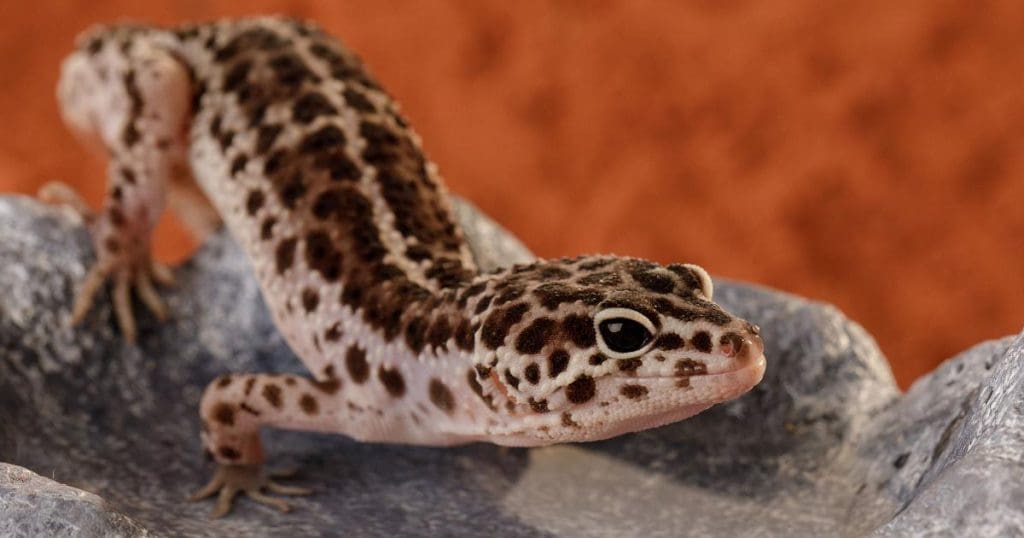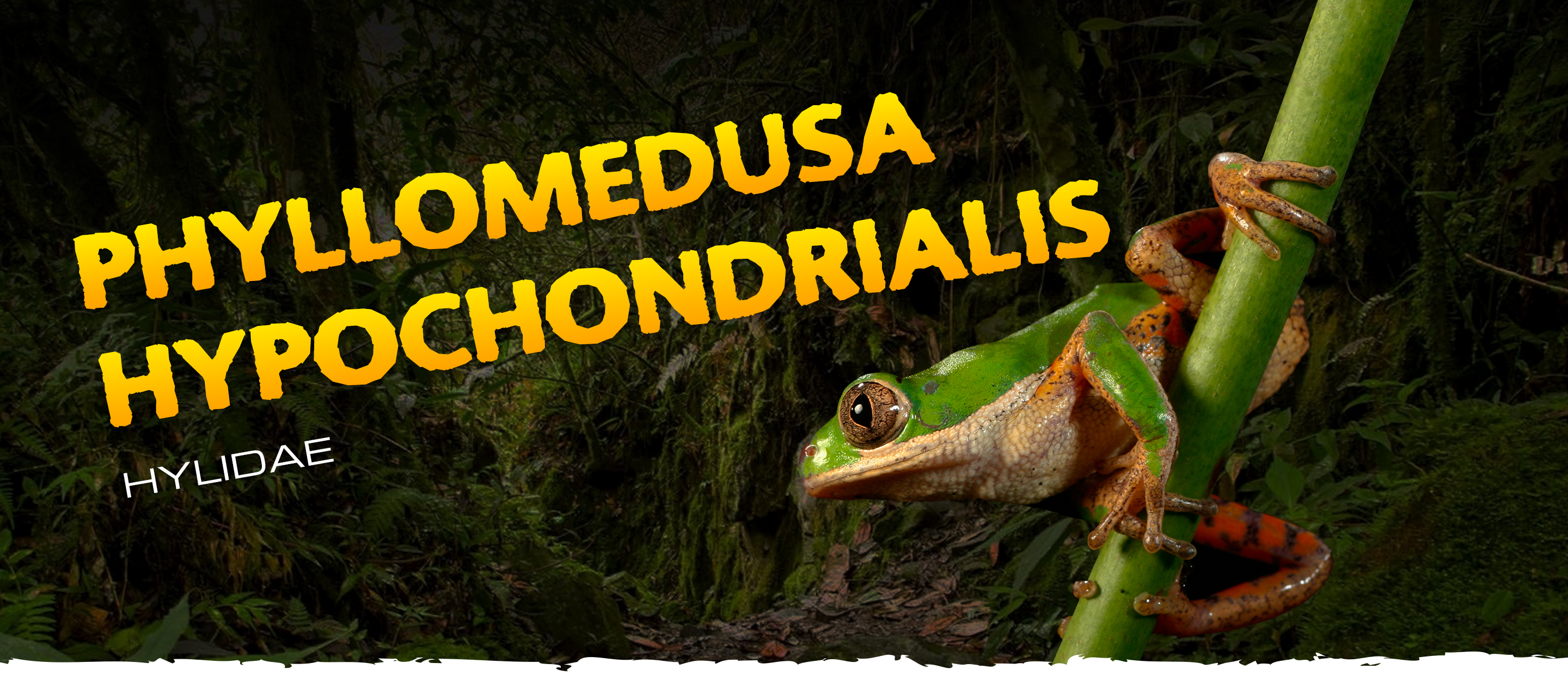
Phyllomedusa hypochondrialis (Pithecopus hypochondrialis)
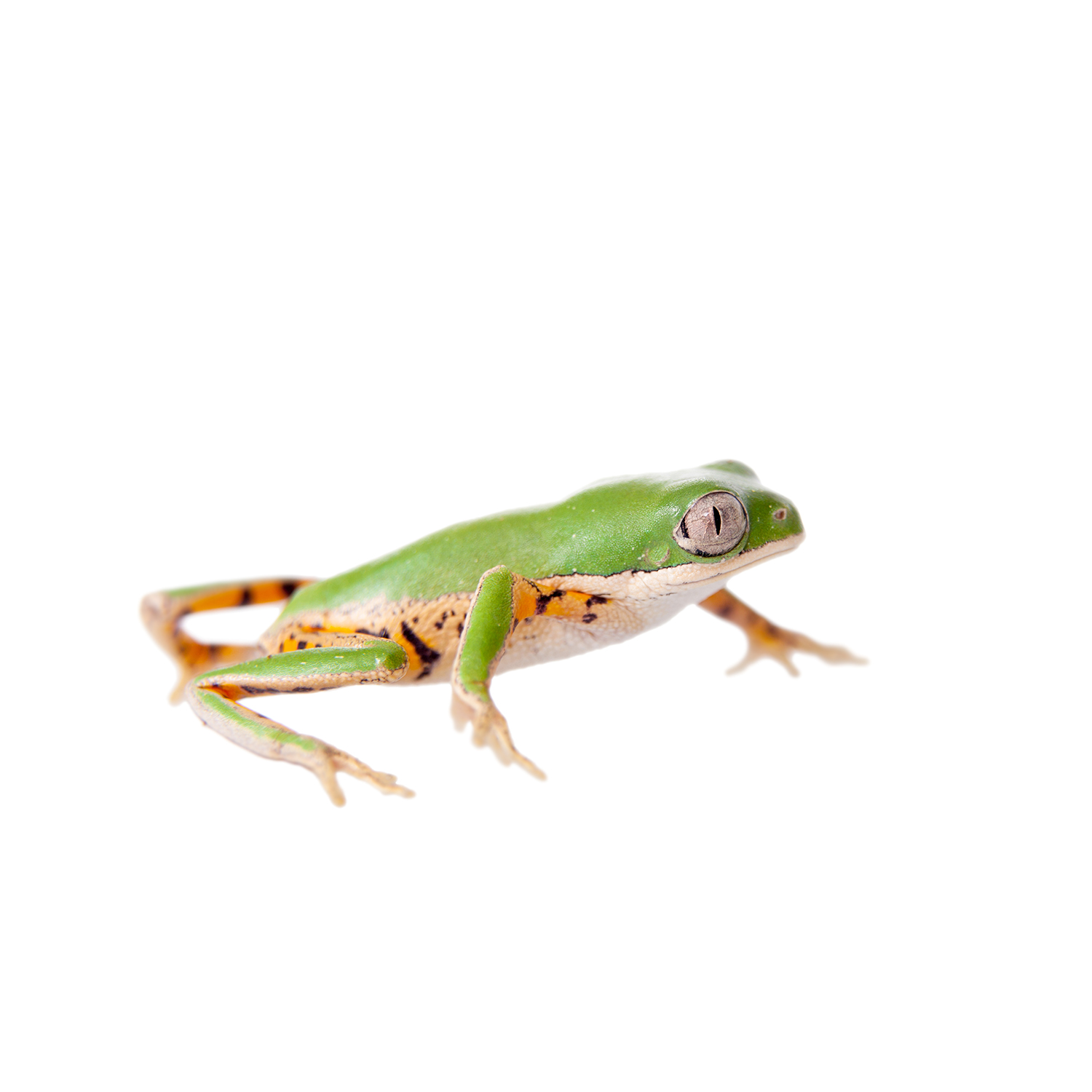

Tiger-Legged Monkey Frog
Tiger-Legged Monkey Frogs are native to Colombia, Venezuela, Suriname, Guyana & French Guyana, Brazil, Bolivia and Paraguay. They prefer tropical & subtropical dry and moist forests but can also be found in seasonally flooded grasslands. The type locality of the Tiger-Legged Monkey Frog referenced in the original description is Suriname.
The Tiger-Legged Monkey Frog's common name refers directly to the striped tiger markings on the inside of the frog's thighs. These frogs really deserve their common name as being Monkey Tree Frogs. Rather than jumping like other frogs do, they prefer to use their long, skinny legs to slowly walk in the trees in a monkey-like fashion. They're also one of the only frogs with opposable thumbs, allowing them to use their monkey-like "hands" to get a firm grip on the thin branches, while walking through the vegetation that they live on.
Tiger-Legged Monkey Frogs are stunning, long-lived and “easy-to-care-for” amphibians. Their engaging personalities, their bright green dorsal color, their orange with black tiger striped inner thighs and partially orange with irregular black stripes and blotches on the flanks, make them one of the most stunning display animals for both the beginning reptile enthusiast as well as for the advanced hobbyist.
Tiger-Legged Monkey Frogs live an arboreal lifestyle, sleeping on the back of the leaves in the trees and shrubs that they live in.
Tiger-Legged Monkey Frogs are a fairly social species and are best enjoyed when kept in small groups of 4 to 8 animals. The interaction between the animals in these small groups increases the viewing pleasure but also stimulates their mating behavior.
Tiger-Legged Monkey Frogs have been captive bred in the USA and Europe for decades. The somewhat larger cousin of the Tiger-Legged Monkey Frog (Phyllomedusa hypochondrialis), the Super Tiger Leg Monkey Tree Frog (Phyllomedusa tomopterna) is also being captive bred, but to a much lesser extent.
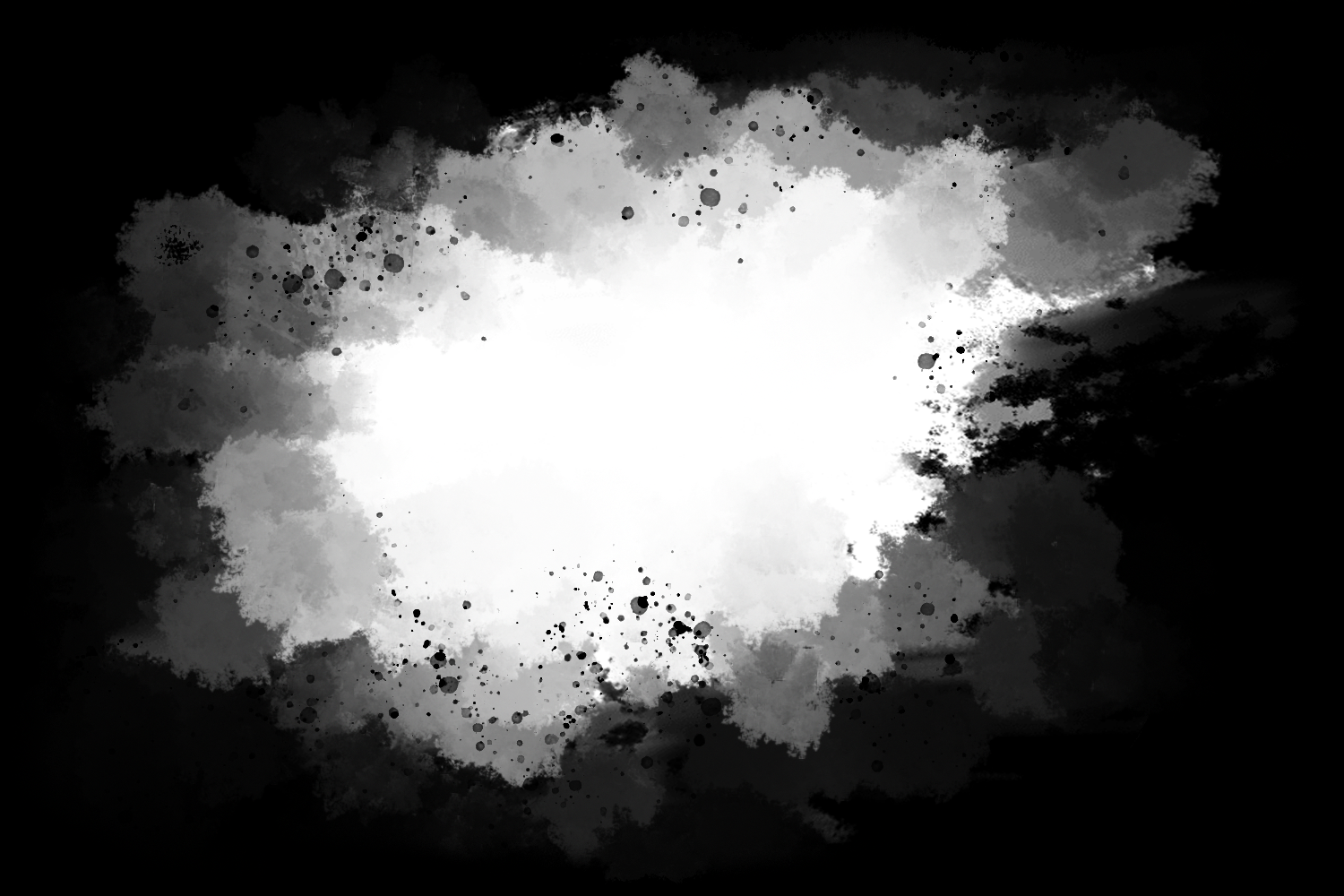
History
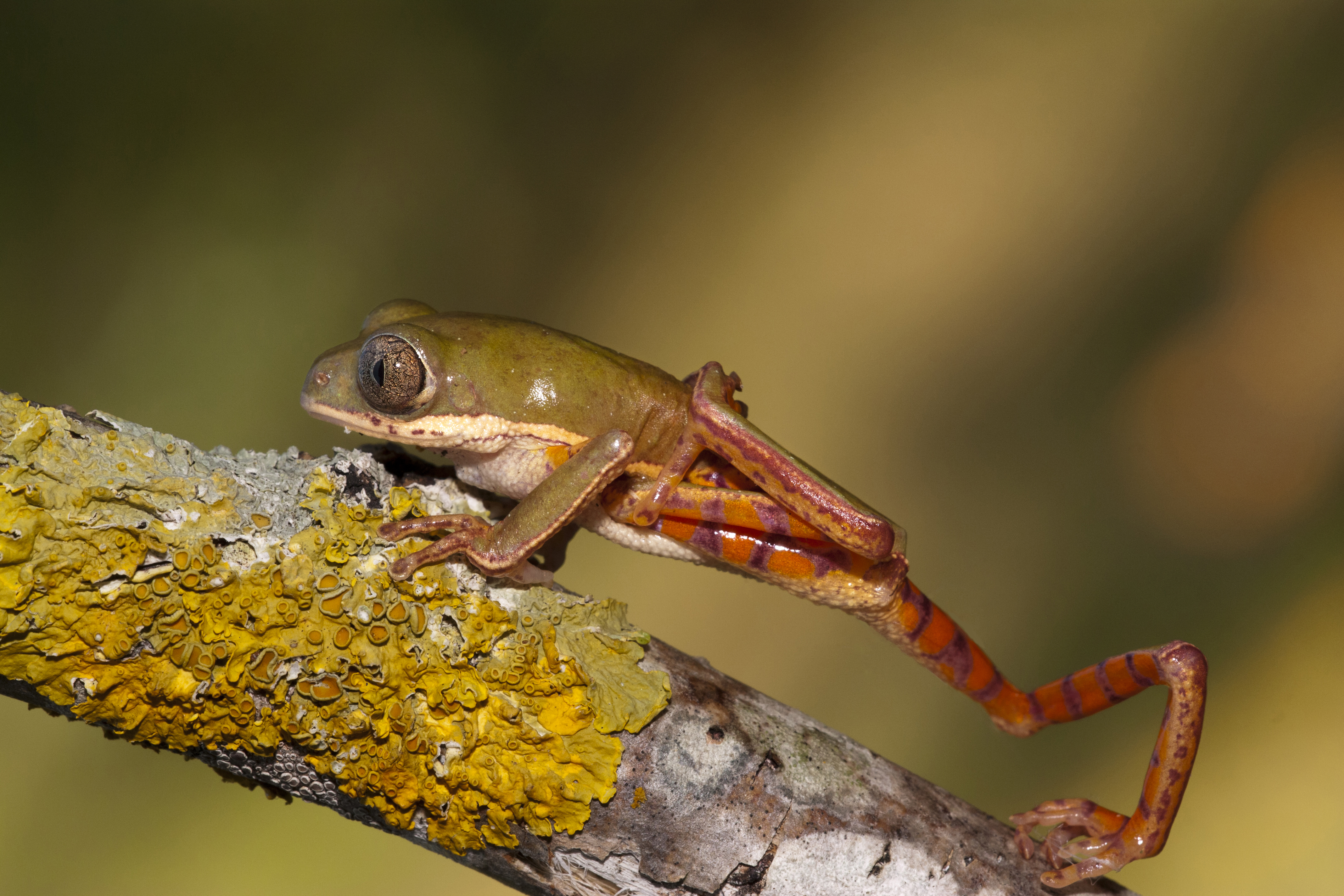
The Tiger-Legged Monkey Frog was first scientifically classified by the French zoologist François Marie Daudin as Hyla hypochondrialis, in his "Histoire Naturelle des quadrupèdes ovipares" in 1800. The holotype that was used by Daudin for the description was collected in Suriname by François Levaillant, a French zoological collector, born in Paramaribo, Dutch Guiana (Surinam).
In 1866, Edward Drinker Cope, an American herpetologist placed the Tiger-Legged Monkey Frog in the genus Pithecopus. Also, Lutz in 1966, and Duellman, Marion and Hedges (in 2016), refer to the Tiger-Legged Monkey Frog as Pithecopus hypochondrialis, but so far, the most commonly used scientific name is Phyllomedusa hypochondrialis.
The name of the Genus Phyllomedusa derives from a composition of two Greek words, namely “phyllo” meaning "leaf" and “medousa” meaning "guardian", so Guardian of the Leaf.
In recent history, the specific epithet hypochondrialis has often wrongly been described as hypocondrialis, missing the "h". Although François Daudin used Rainette hypochondriale to describe the Tiger-Legged Monkey Frog, the people in French Guyana call it the "Phylloméduse à lèvres blanches", or white-lipped Phyllomedusa.
Tiger-Legged Monkey Frogs are amphibians, a word that derives from the Ancient Greek word "amphibios", meaning "to live a double life”, one as a tadpole in water, one as a frog on land.
Characteristics
Tiger-Legged Monkey Frogs belong to the family Hylidae and the subfamily Phyllomedusinae.
Tiger-Legged Monkey Frogs are slender, colorful, arboreal frogs. The frog's smooth dorsal skin consists of a bright green coloration, while the belly and the frog's lips are creamy-white. The flanks are partially orange on a creamy-white background, covered with irregular black stripes and blotches. The inner thighs and feet are orange with a black tiger striped pattern. Their feet are not webbed, but instead have opposable thumbs, which allows them to firmly grasp thin branches and climb in a monkey-like fashion. Their big grey eyes have vertical pupils, typical for members of the Phyllomedusinae subfamily.
With this extensive palette of colors and its graceful physique, this frog certainly belongs in the top ranking of the most beautiful tree frogs in the world.
To prevent evaporation during daytime, as well as to camouflage themselves, while sleeping underneath a leaf in the trees and shrubs where they live, they keep their big grey eyes closed and tuck their limbs up against their body, so they're actually hardly recognisable as a frog.
The genus Phyllomedusa is known for their ability to wax their body to prevent them from dehydrating during drier periods. The Tiger-Legged Monkey Frog covers its skin with a waxy lipid coating, using its front and hind feet. These pharmacologically active lipid secretions prevent evaporative water loss, bacterial and fungal infections, and allow the frogs to briefly sunbathe without the risk of desiccation.
While mating, Tiger-Legged Monkey Frogs perform an intimate embrace, called the amplexus. During the breeding season, males develop brown nuptial (mating) pads with a roughened surface on the first digit of their forelegs. These pads not only serve to improve the male's grip on the female during amplexus, but glands below the surface of the nuptial pads also secrete pheromones (amplexins) that may influence the courtship duration. The males perform a loud mating call to attract the females. It usually starts with the croaking of 1 male, but soon others will join the serenade.
Adult frogs range from 2-2.5" or 5-6cm in total length; males are typically smaller and slenderer than females. Once adult, the male frogs can be recognised by the loose skin on their throat, indicating their “vocal sac”.
If well fed & maintained, they can reach adult size and sexual maturity in 12-16 months and can live up to 10+ years.
Distribution
This species occurs mainly in the Amazonian region and can be found from Colombia to Venezuela, Suriname, Guyana & French Guyana, Brazil, Bolivia and even the Northern part of Paraguay. They prefer tropical & subtropical dry and moist forests but can also be found in seasonally flooded grasslands.
In the Wild
Tiger-Legged Monkey Frogs are arboreal and inhabit low to mid elevation tropical & subtropical dry and moist forests but can also be found in seasonally flooded grasslands and even in rural gardens.
Tiger-Legged Monkey Frogs are both crepuscular and nocturnal, they sleep on the back of larger leaves in the shrubs during daytime and start foraging the shrubs at night to feed on insects.
To prevent evaporation during daytime, as well as to camouflage themselves, while sleeping underneath a leaf in the trees and shrubs where they live, they keep their big grey eyes closed and tuck their limbs up against their body, so they're actually hardly recognisable as a frog.
When at sleep during the day, the frog doesn't have to completely close its eyelids, but instead can rely on its translucent, eyelid-membrane to keep the eyes from dehydrating. These translucent, somewhat reticulated, eyelid-membranes, allow the frog to keep "a keen eye" on potential predators, without the need to open its actual eyelids. But once disturbed in his sleep by a potential predator, the frog rapidly opens its eyes, show its striking orange sides and feet in order to confuse the predator for a few seconds... enough to leap into the air and disappear into the shrubs.
The breeding season of Tiger-Legged Monkey Frogs usually occurs during the rainy season, mostly between December up to May. At nighttime, during the breeding season, males continuously perform their mating call to attract the females. When another male enters the territory, the male Tiger-Legged Monkey Frog will perform a territorial call to warn the trespasser. In case the intruder remains on site, the 2 males might even engage in physical combat.
The tropical & subtropical dry and moist forests that Tiger-Legged Monkey Frogs inhabit have a stable temperature, with daytime temperatures fluctuating between 75-85°F or 24-29°C, and only a slight nighttime drop to 68-75°F or 20-24°C. The temperatures in the habitat of Tiger-Legged Monkey Frogs also vary only slightly between the rainy season and the dry season. With a variation of only 2-4 °F/°C, the temperatures do not differ much between the dry season and the rainy season.

In the Terrarium
Tiger-Legged Monkey Frogs are strictly crepuscular and nocturnal and should best be fed when they are awake. Disturbing them during daytime hours is not recommended.
Because Tiger-Legged Monkey Frogs are arboreal and prefer to live very near to a water body, a vertically oriented, well-ventilated paludarium suits their lifestyle best. A paludarium is a semi-aquatic terrarium habitat that replicates a rainforest, swamp or stream and can harbour aquatic as well as terrestrial animal and plant species. The bottom part has an extra high front bottom glass, providing a higher water level and an increased water volume compared to common terrariums. This enables you to incorporate a substantial water part or aquarium section which allows you to keep aquatic animals and plants adjacent to the land or terrarium section. A part of the aquatic section can consist of a false bottom to support the land section, accommodate and hide the aquatic appliances like filters, pumps and water heaters and can double as a biological filtration media.
Tiger-Legged Monkey Frogs are a fairly social species and are best enjoyed when kept in small groups of 4 to 8 animals. The interaction between the animals in these small groups increases the viewing pleasure but also stimulates their mating behavior.
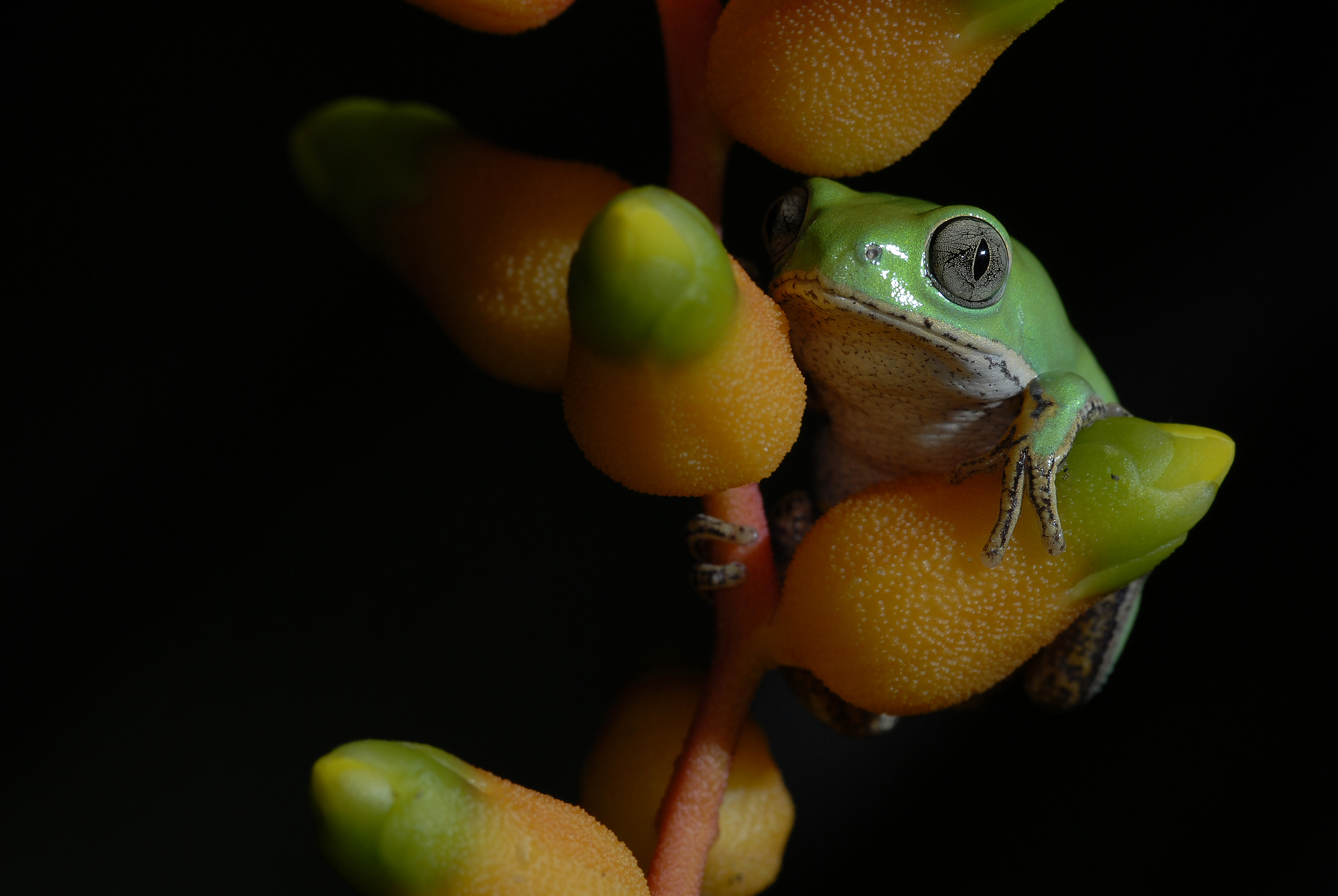

Terrarium
Exo Terra® Natural Terrariums are designed by European herpetologists and offer several housing options for Tiger-Legged Monkey Frogs. These glass terrariums feature front opening doors, allowing easy access for maintenance and feeding and a unique double ventilation system with full screen stainless steel top.
The Exo Terra® Natural Terrarium X-Tall (Paludarium) range allows you to create a semi-aquatic terrarium habitat that replicates a rainforest, swamp or stream and can harbour aquatic as well as terrestrial animal and plant species. The bottom part has an extra high front bottom glass, providing a higher water level and an increased water volume compared to common terrariums. A part of the aquatic section can consist of a false bottom to support the land section, accommodate and hide the aquatic appliances like filters, pumps and water heaters and can double as a biological filtration media.
The Exo Terra® Tree Frog Terrarium even comes with a built-in drain and tap valve which allows you to easily drain out excess spray water. This drain will come in handy when simulating the rainy season to induce mating behaviour in your frogs. The single front opening door allows maximum viewing pleasure and provides easy access for maintenance and feeding. A push-button lock keeps the terrarium secure and can even be outfitted with an optional lock to prevent unwanted opening. The hinged cover can be locked and unlocked with a single button and can be fully opened. A clear glass panel in the front ensures maximum visible light penetration and a stainless-steel ventilation strip in the back guarantees optimal ventilation. The patented dual ventilation system keeps the single front glass door free of condensation, even in humid conditions. It creates a natural upward flow of air to ensure optimal and healthy conditions. Excess heat is dissipated through the top mesh and prevents heat from accumulating, creating temperature gradients in the terrarium. The screen mesh allows UV and infrared penetration when these bulbs are required. Four self-closing inlets for wire/tubing in the back facilitate the installation of powered accessories like waterfall pumps, filters, the Exo Terra®'s Monsoon, etc. The inside front of the lid has a Monsoon Nozzle mounting point on each side of the terrarium. The bottom part of the terrarium is waterproof once the tubing, elbow-connector and tap valve are connected to the drain. The drain allows hassle free water changes and excess water removal.
The Exo Terra® Frog Terrariums can be set up as a bioactive habitat for dart frogs, smaller tree & reed frogs, newts and salamanders, small geckoes & lizards, garter & grass snakes, etc.
Because of the Tiger-Legged Monkey Frog’s arboreal lifestyle and preference of living in the vicinity of water, the vertically oriented space and possibility to create a paludarium make the Tall and X-Tall Natural Terrariums the ideal enclosure for small groups of Tiger-Legged Monkey Frogs:
The set-up can be a simple “rain chamber-type” terrarium with a 2-6 inches (5-15cm) water part and some branches or a more natural bio-active type set-up with a separate land and water part mimicking a lakeshore or riverbank, by using the Bio Drain system. In both set-ups, you will need to provide ample climbing space by strategically placing branches, cork pieces and vines in the terrarium. By arranging these perches diagonally, the frogs will be able to thermoregulate, choose the amount of UVB they want to absorb, etc. With a combination of sturdy artificial and live plants, you can provide the much-needed foliage which will allow the frogs to rest and hide in shaded areas of the Terrarium.
DISCLAIMER In regards to the pet species and number of specimens to be kept in a terrarium, always comply with the species specific Rules and Regulations in your Country of residence.
DISCLAIMER The terrarium should be placed in a room receiving only indirect light from windows. Do not place the Terrarium near a window where it can receive direct sunlight, as this could cause the terrarium to overheat and stress or kill your Tiger-Legged Monkey Frogs.
Lighting
Although Tiger-Legged Monkey Frogs are mainly crepuscular to nocturnal, they will sometimes be active during daytime. A 12-hour day/night cycle will benefit your frogs and stimulate live plant growth. The Exo Terra® TerraSky Planted Terrarium Light is ideal for planted setups, paludariums and bioactive terrariums. The high intensity and enhanced penetration ensure that the light reaches all layers of the terrarium, resulting in sustained lush plant growth. Orchids, Bromeliads, Tillandsias (air plants), carnivorous plants, mosses and lichen all thrive under the TerraSky Planted Terrarium Light’s strong Photosynthetic Active Radiation (PAR). The 120-degree light dispersion provides a nice even illumination and covers the complete area to avoid dark spots.
Providing UV-lighting is not absolutely necessary, but the correct amounts of UVB will help your frogs to metabolize calcium and prevent metabolic bone disease. The combination of the correct UVB wavelength and heat enables the animals to produce their own vitamin D3 for proper calcium absorption and prevents metabolic diseases (e.g., MBD). We highly recommend the use of our Reptile UVB100. The low levels of UVB-rays produced by these bulbs are very beneficial for the animal's overall health, while the UVA rays stimulate appetite, activity and reproductive behavior.
Heating
Monitoring
During the day, an average relative humidity of 65-70% and terrarium temperature of 75-85°F or 24-29°C should be maintained. At night, humidity should rise up to about 90% while the terrarium temperature can drop to 68-75°F or 20-24°C. Use the Exo Terra® Digital or Analog Thermometers and Hygrometers to help you monitor the terrarium conditions and adjust the temperature and relative humidity to meet the needs of the animals.
For more security and peace of mind, the Exo Terra® Thermostats or Thermostat & Hygrostat will help to prevent overheating and undercooling during hot summer days or cold winter nights. Apart from the temperature, the Exo Terra® Thermostat & Hygrostat will also keep the humidity at the desired level, if used in combination with an Exo Terra® Humidifier or Fogger. With the Exo Terra® Thermostats or Thermostat & Hygrostat, you can create a well-controlled heating/humidifying system that allows you to maintain the required temperature and/or humidity conditions similar to those found in your animal's environment.
Substrates
Tiger-Legged Monkey Frogs thrive well in a paludarium setup. The Paludarium’s living space consists of 3 distinct zones:
Terrestrial Zone The terrestrial zone is a land area with plants, trees, bushes and rocks that never submerge. In tropical climates a variety of invertebrates, reptiles and amphibians occur here.
Riparian Zone The riparian zone or riverbank is the interface between land and water. It is inhabited by semi-aquatic reptiles and amphibians.
Aquatic Zone The aquatic zone can be a stream, pond or even lake – home to turtles, aquatic amphibians, fishes and freshwater shrimps.
To create the Terrestrial and Riparian Zone, you can use Bio Drain Substrate with a Bio Drain Mesh, topped with Exo Terra® Sub Stratum and/or Plantation Soil, covered with leaf litter and/or moss (Exo Terra® Equatorial Forest Floor or Forest Moss). The non-toxic Bio Drain mesh will keep the underlying Bio Drain Draining Substrate separated from the decorative top-layer substrate. It will prevent substrate particles from contaminating the water while still allowing proper water drainage. In combination with the Bio Drain Substrate, you can create water parts and a biological filtration system in the terrarium. The clean terrarium water can then be circulated in Waterfalls, Cascades or Dripping Plants. In the Terrestrial Zone, you can build your decorative layer with plants, branches, lianas, rocks, hides, etc. The actual substrate layer that will be used for planting can consist of mixture of Exo Terra® Sub Stratum with Exo Terra® Plantation Soil. The Riparian Zone remains somewhat open, with some smaller pebbles, or flat wood or stone pieces that allow easy access to the Aquatic Zone. For the Aquatic Zone, Turtle Pebbles are a great choice as their dimensions are big enough to avoid being swallowed by the frogs, but offer a stable substrate and are easy to clean.
The Exo Terra® Sub Stratum is a natural volcanic soil with live beneficial bacteria. The porous surface and low-density structure allow for excellent drainage and aeration, but it also promotes a flourishing population of beneficial, nitrifying bacteria, creating a self-sustaining, living terrarium ecosystem. The active beneficial bacteria of the soil will decompose biological waste, keeping the terrarium clean and healthy. By mixing the Sub Stratum with other organic substrates, you enrich any substrate with the required minerals like calcium, nitrogen, potassium and phosphorus. It also aids in the water retention capacity and provide adequate air supply to the roots.
The Exo Terra® Equatorial Forest Floor is a multi-layer substrate that allows you to recreate the forest floor as found in natural equatorial forests. The Equatorial Forest Floor provides a base layer and a top layer. The base layer consists of a rich organic matter from ground coconut husk fiber. It is a 100% natural, ecological and biodegradable substrate with great hygroscopic properties. The top layer consists of sun dried decorative Ardisia leaves from a sustainable resource. The top layer covers the actual substrate underneath to facilitate its moisture retention and prevent the soil from drying out.
The Exo Terra® Forest Moss is real compressed moss grown in tropical Asia and does not contain any dyes or chemicals. This ecological substrate is extremely absorbent and ideal for increasing humidity in the terrarium. It is totally safe for use with frogs, salamanders and burrowing or digging animals.
The Exo Terra® Plantation Soil is a 100% natural, biodegradable terrarium substrate made from sustainable, ground coconut husk fiber grown on plantations in tropical Asia. The unique hygroscopic properties of this ecological substrate regulate the terrarium’s humidity in a natural way and is totally safe for frogs, salamanders and other burrowing or digging animals. The unique coir pith used for the Exo Terra® Plantation Soil consists of a mixture of short fibers and coco-peat grain sizes ranging from coarse granules to fine clumps resulting in improved soil drainage and aeration. The improved aeration of the substrate promotes the cultivation of healthy waste-reducing organisms keeping your terrarium fresh and clean.
The substrate should be kept moist at all times, but definitely not soaking wet. Make sure to offer different gradients of moisture inside the terrarium. Some parts can be kept rather moist while other parts should be kept somewhat drier. Also, try to vary the moisture depending on the season, spray more frequently during the warmer parts of the year.
The Exo Terra® substrates will help maintain the substrate moisture at an optimal level. Providing a top layer of Exo Terra® Equatorial Forest Floor or Forest Moss will also facilitate the substrate's moisture retention and prevent it from drying out. The ardisia leaves or forest moss also provides hiding spots for the reptiles and amphibians foraging the forest floor and at the same time, facilitate the natural ecosystem where beneficial organisms will break down waste products and thus reduce odors.
The secret to growing healthy plants begins with the soil. Naturally, healthy soil contains living microorganisms — from bacteria to fungi, protozoa and arthropods. Together, they form a choreographed exchange from the recycling of nutrients to the decomposition of organic materials.
Plants
The land part of the terrarium can partially be decorated with live and/or Exo Terra® artificial or smart plants. Live plants and moss will contribute to the filtration capacities of your terrarium. This type of setup allows you to create an effective filtration system, mirroring the process of natural biological filtration. A fully functioning aqua-terrarium or paludarium will provide a constant source of clean water, which is imperative to keep semi-aquatic species. It is basically a small, closed ecosystem.
Ideal for Tree Frogs are all the vining plants like Philodendron, Epipremnum (pothos) and Scindapsus, etc. but also other sturdy large-leaved plants like Aglaonema, Dieffenbachia, Monstera are well accepted as sleeping, hiding and mating places.
Many hobbyists choose to introduce live plants in pots that are buried in the substrate and concealed with decor items, like cork bark or rocks. The Exo Terra® Snake Bowl can be used as a decorative planting pot. Its extra deep design makes it suitable for small to medium live terrarium plants.
DISCLAIMER Make sure the plants have no pests before introduction and rinse leaves thoroughly to remove any pesticide residues.
Exo Terra® offers a wide range of artificial plant with the same advantages as live plants; they're decorative, they provide shade, and they create hiding spots and visual barriers to let your reptiles and amphibians experience an increased feeling of safety and reduced stress. Exo Terra®'s artificial plants are exact copies of their natural counterparts to blend in well with live plants but are much easier to maintain. A combination of live plants and Exo Terra®'s artificial plants allows you to fully plant a terrarium, even in the hottest or driest parts.
Exo Terra®'s Bromeliad's, Scindapsus, Philodendron and hanging Plants are easy to clean & maintain, while the weighted base of the Bromeliad's, Scindapsus, Philodendron allows you to easily position the plant after maintenance.
Hide Outs
Exo Terra®'s Bromelia's, Scindapsus, Philodendron and hanging Plants will help to provide visual barriers.
An additional decorative hide like the Exo Terra® Canopy Cave will add even more privacy to your frog's habitat.
Decor
Landscaping a terrarium will not only encourage the frog's activity and exploratory behavior, but also provide extra cover which increases the frog's sense of security and reduces its stress levels.
The land part of the terrarium can partially be decorated with live and/or Exo Terra® artificial or smart plants. Various branches can be used to create climbing space. Adding Exo Terra® Vines is a great way to create more climbing space. These waterproof vines are bendable, twistable life-like vines with a natural feel and look and can be twisted together with vines of different sizes to create a 3-D habitat. The Exo Terra® Jungle Vines and Moss Vines can be combined to enhance the natural Rainforest-look of your Terrarium.
Waterfalls and Cascades add aesthetic appeal and will help oxygenate and biologically filter the water.
The Exo Terra® Frog Pond and Coconut Water Dish have a realistic design and will enhance the naturalistic flair of the habitat's design.
Exo Terra® offers a wide variety of innovative decor items like Skulls, Waterfalls, Ground Cover Plants, etc. - all of which add, next to personalising accents, some more environment enrichment and features.
Nutrition
Tiger-Legged Monkey Frogs are insectivorous and should be fed with a variety of live, canned or vacuum-packed insects of appropriate size. As a general rule, the maximum size of the insects should be the width of the frog’s head. Offer as much variety of insects, in your Tiger-Legged Monkey Frog's diet, as possible, to make sure that your frog receives all possible essential nutrients. All live insects should be gut-loaded with nutritious foods, like apple slices, sweet potato, oranges, cereals, bee pollen, etc., 24-48 hours prior to being fed to your frog.
Tiger-Legged Monkey Frogs can be picky eaters and will not always accept all insects equally well. They tend to dislike all worm-type insects, like mealworms or Superworms, at one moment, but then at another moment, they will readily accept them. It also takes Tiger-Legged Monkey Frogs a little while to get used to tweezer feeding, but after some training, most of them will accept it.
Because commercially raised insects tend to be deficient in calcium and several vitamins, they must be supplemented by coating with a reptile vitamin and mineral supplement such as Exo Terra® Multi Vitamin blended with an equal part Calcium. Always dust your feeder insects with a 1:1 mix of Exo Terra® Multi Vitamin and Calcium + D3 powder supplement using the “shake & bake” method of coating insects.
Exo Terra® Canned or Vacuum-Packed insects can be fed right out of the can/pouch as these insects are well fed and vitamin-calcium coated.
Exo Terra® offers 11 varieties of Canned and Vacuum-Packed Foods which allow you to bring more variety in your Tiger-Legged Monkey Frog's diet. After some training, Tiger-Legged Monkey Frogs will accept canned or vacuum-packed foods if you use tweezers to make the insects appear to be alive. Just hold the insect in front of the frog and slowly wiggle it so it appears to be moving. Loosen the tweezers as soon as the frog grabs the insect. The Exo Terra® Canned and Vacuum-Packed Specialty Reptile Foods are a convenient way to feed insect eating reptiles, turtles, amphibians, fish and birds. These insects (and snails) have been cooked in the can to maintain nutritional value, flavor and aroma. The retorting process also softens the exoskeleton of the insects for easier digestion and breaks the bonds between the collagen protein to make it absorbable by reptiles. Collagen is an important fiber that aids in building bone, cartilage, skin and claw structures. Canned and Vacuum-Packed insects have the same nutritional value as live insects but are easier to digest. Visit our Canned and Vacuum-Packed Foods webpage for more information.
Feed juveniles daily and adults every second or third day.
Water
The presence of clean and fresh water is important for the proper care and maintenance of captive reptiles and amphibians.
Because Tiger-Legged Monkey Frogs may bathe and soak up water via their skin, but also because they lay their eggs above water, you should always offer fresh and clean water. Always treat tap water with Aquatize to remove harmful heavy metals, chlorine and chloramines, necessary to provide safe healthy water for your captive reptiles and amphibians. In a bio-active set-up, you can use Exo Terra® Turtle Clean (PT1998) to add beneficial organisms to the terrarium water and speed up the biological filtration capabilities. Liquid Electrolyte and Calcium can be added to the water to support healthy bone and muscle growth in your frogs and especially tadpoles.
An ideal Water Dish for use with amphibians is the Exo Terra® Frog Pond. The Exo Terra® Frog Pond has a very natural and realistic pebble-rock finish that integrates in any type of terrarium. The Frog Pond’s unique shape allows you to install the pond semi-recessed in the substrate to mimic a riparian zone. This design offers easy access for reptiles and amphibians to hydrate while the shallow water body and integrated steps prevent the animals from drowning.
The average humidity should be kept between 65-70% with peaks of 90% in the morning and evening (when the terrarium is sprayed/misted), similar to what these frogs experience in nature. The Exo Terra® Monsoon is a handy device to guarantee that your frog terrarium is sprayed at a set time every day. The Exo Terra® Humidifier can help maintain the correct relative humidity in the terrarium, especially if used in combination with the Exo Terra® Thermostat & Hygrostat. Make sure the Terrarium is well ventilated and the humidity is not kept permanently above 70% as even Tiger-Legged Monkey Frogs may develop bacterial skin infections.
As also seen in some other tree frogs, like Agalychnis, the Phyllomedusa hypochondrialis have a highly permeable underside with which they can absorb moisture that forms on leaves due to condensation or by raindrops running down the leaves, to prevent dehydration.
Maintenance
Land area;
Spot-clean your Tiger-Legged Monkey Frog's enclosure once a week or more if necessary; remove fresh or dried faeces, dead insects, etc. For a more thorough cleaning, remove all the decor pieces and clean these with warm water. Always keep a keen eye on the substrate; as long as the substrate is not degrading or does not have a foul odor, the spot cleaning process is sufficient. Once the substrate starts to degrade or spreads a foul odor, it needs to be replaced completely.
Water part;
When using a water circulation pump or filter, it is best to clean the water inlet and filter media every 2-3 weeks to ensure optimal performance. Water changes should be performed on a bi-weekly basis; remove about ¼ to ⅓ of the water and replace it with fresh water of the appropriate temperature. Partial water changes can help to remove toxic substances or improve the overall water quality. Unless really necessary, make sure to never perform entire water changes, as this will also remove beneficial bacteria and organisms. Always treat tap water with Aquatize to remove harmful heavy metals, chlorine and chloramines when performing water changes. Use Turtle Clean (PT 1998) to assure that the beneficial organisms in the terrarium water remain at an ideal level to keep the biological filtration system performing well.
Breeding
In the wild, Tiger-Legged Monkey Frogs breed after heavy summer rains. In order to simulate these conditions, you first have to reduce the light cycle from 12 to 10 hours daily and keep the temperature at 72°F or 22°C for about 5-6 weeks. Keep the humidity at the lower end (60%) and reduce spraying intervals from 2-3 times daily to 2-3 times weekly, to simulate a drier, cooler winter period. Allow the water temperature in the Paludarium section to drop to 70-72°F or 21-22°C. Feed the frogs only sparingly during this brumation period. After this 5-6 weeks brumation period, the light cycle should be increased to 12 hours daily again, and the temperatures restored to the normal settings (75-85°F or 24-29°C). At this point, the water temperature in the Paludarium section should also be restored to its normal 78°F or 25°C. Exo Terra® Turtle Heaters are convenient to use as they are preset to 78-79°F or 25-26°C.
The spray intervals should be increased again to simulate the rainy season, and average humidity can be kept at 80-85%. The frogs will become more active and start feeding a bit more than average. After a week, proceed with spraying/misting the terrarium extensively to simulate heavy summer rains. In reaction to the simulated summer rains, the males will start their mating call to attract females and grasp them behind the front arms to hold them in an amplexus.
A male surplus of 2 males for 1 female will definitely encourage healthy competition between the male specimens in the terrarium, resulting in successful matings and best breeding results.
After a breeding pair has formed, the female will descend into the water, still carrying the amplectant male on her back, and start soaking up water into her bladder. She will use this water to create the gelatinous mass encapsulating the egg. The pair will then make their way back to the shrubs and search for a suitable, sturdy leaf, positioned over the water, to deposit the arboreal egg clutch of between 30-70 eggs. While the female, still carrying the male on her back, holds onto the leaf and deposits the eggs on the lower midrib of the leaf, the male will fertilise the eggs externally. Once the eggs are deposited on the midrib of the leaf, the female will start wrapping the leaf around the eggs to guard them against predators and avoid desiccation. The female may also deposit gelatinous egg capsules together with the actual eggs to prevent desiccation.
After about 7-10 days, the eggs are ready to hatch and the tiny tadpoles will start to wriggle themselves free from the gelatinous mass. Since the egg clutches are attached to leaves overhanging the water, the hatching tadpoles simply drop into the water underneath and remain motionless for several days.
After the pairings have been completed, and the eggs have been laid and hatched, the average humidity can be reduced to the normal 65-70% again.
Alternatively to hatching the eggs in the "parents" Terrarium, you can also cut off the leaves that have eggs adhered to them, and move these to a specific hatching terrarium. You can stick the leaves to the glass sides of the terrarium using self-adhesive tape. Make sure that when the eggs hatch, the tadpoles will drop into the water below.
Once the tadpoles start swimming, they will also start feeding on frog & tadpole food, dead insects, chopped earthworms, fish food flakes, algae, plants, etc. When the metamorphosis is close to completion, it is critical to provide the tadpoles with sufficient plants, branches or a smooth levelled riverbank so they have easy access to the land area.
The newly-emerged frogs will absorb the remnants of their tail for the next few days and will then start feeding on food items of appropriate size like fruit flies, freshly hatched crickets, bloodworm, hatchling waxworms, flour moth larvae, etc. As with adults, always dust the feeder insects with a 1:1 mix of Exo Terra® Multivitamin and Calcium +D3 powder supplement. The freshly metamorphosed frogs can be raised under similar conditions as used for the adult frogs, just make sure the water isn’t too deep, and there are slopes available so the frogs can easily climb onto land areas.
Handling
Tiger-Legged Monkey Frogs are lively and agile frogs and do not tolerate frequent handling very well. When held for a longer period, they will try to escape and may leap in the air, fall and hurt themselves. Therefore, we do not recommend excessive handling. If you need to inspect one of your frogs, you may want to consider guiding the frog into a clear plastic tub without even touching the frog. Like most amphibians, Tiger-Legged Monkey Frogs have a very sensitive skin, and are especially sensitive to chemicals like soap, lotion, etc. so make sure to always thoroughly wash and rinse your hands with warm water before and after handling any amphibian.
Every amphibian’s skin contains very mildly toxic substances that can irritate eyes or open wounds so always thoroughly wash and rinse your hands with warm water before and after handling any amphibian. If you accidentally touch your eyes while handling an amphibian, you might experience a somewhat burning sensation. Should this happen, make sure to rinse your eyes immediately and thoroughly with water, that should relief the burning sensation immediately.
DISCLAIMER Always make sure to thoroughly wash and rinse your hands with warm water before and after handling any reptile, amphibian or invertebrate.

Conclusion
Tiger-Legged Monkey Frogs are hardy, long-lived and “easy-to-care-for” amphibians. Their engaging personalities, their bright green dorsal color, their orange with black tiger striped inner thighs and partially orange with irregular black stripes and blotches on the flanks, make them one of the most stunning display animals for both the beginning reptile enthusiast as well as for the advanced hobbyist.
Tiger-Legged Monkey Frogs have been captive bred in the USA and Europe for decades. The somewhat larger cousin of the Tiger-Legged Monkey Frog (Phyllomedusa hypochondrialis), the Super Tiger Leg Monkey Tree Frog (Phyllomedusa tomopterna) is also being captive bred, but to a much lesser extent. Tiger-Legged Monkey Frogs are a fairly social species and the interaction between the animals kept in small groups, make them perfect for display and observation.

Did You Know?
Tiger-Legged Monkey Frogs are very common in their native countries, that is why they have the IUCN predicate conservation status: LC “Least Concern”. Tiger-Legged Monkey Frogs are also abundantly available as captive bred specimen.
Although the Tiger-Legged Monkey Frogs are mainly arboreal, they still prefer to live very close to waterbodies, especially near ponds, lakes, streams and wetlands, which are home to lots of floating plants (such as water hyacinth), grasses, or reeds.
Tiger-Legged Monkey Frogs secrete bioactive peptides on their skin that have medical, antibacterial activity. They also help the frogs fight against predators and pathogens.
Tiger-Legged Monkey Frogs use nuptial pads to tighten their grip during the amplexus (mating). These pads not only serve to improve the male's grip on the female during amplexus, but glands below the surface of the nuptial pads also secrete pheromones (amplexins) that may influence the courtship duration.
Tiger-Legged Monkey Frogs use vibration to communicate with females and especially use "release" vibrations when they are accidentally amplexed by a competing male.
Frequently Asked Questions
Are Tiger-Legged Monkey Frogs the right choice for me?
Tiger-Legged Monkey Frogs are hardy, long-lived and “easy-to-care-for” amphibians. Their engaging personalities, their bright green dorsal color, their orange with black tiger striped inner thighs and partially orange with irregular black stripes and blotches on the flanks make them one of the most stunning display animals for both the beginning reptile enthusiast as well as for the advanced hobbyist.
Can I feed my Tiger-Legged Monkey Frogs wild caught insects?
We do not recommend feeding wild caught insects as these can harbor harmful bacteria. They may also have come in contact with gardening chemicals, making them poisonous for your Frogs.
Should I feed a variety of food items to my Tiger-Legged Monkey Frogs or can I stick to just 1 type feeder insect?
Bring as much as possible variation in your Tiger-Legged Monkey Frog's diet to make sure that your frog receives all possible essential nutrients. With Exo Terra®'s Canned or Vacuum-Packed insects, it's easy to offer a wide variety to make sure that your frogs receive all the nutrients they need. The Canned and Vacuum-Packed insects have the same nutritional value as live insects but are easier to digest.
Can I keep other amphibians and reptiles together with my Tiger-Legged Monkey Frogs?
Tiger-Legged Monkey Frogs are best kept in a small group of their own kind. Other species, especially diurnal animals, could disturb the frog's sleep.
Are Tiger-Legged Monkey Frogs poisonous?
Tiger-Legged Monkey Frog's mild toxicity works as a defense mechanism against predators, but also prevents bacterial and fungal infection. Every amphibian’s skin contains very mildly toxic substances that can irritate eyes or open wounds so always thoroughly wash and rinse your hands with warm water before and after handling any amphibian. If you accidentally touch your eyes while handling an amphibian, you might experience a somewhat burning sensation. Should this happen, make sure to rinse your eyes immediately and thoroughly with water, that should relief the burning sensation immediately.

Other species
Dendrobates auratus
The green-and-black poison dart frog, or Dendrobates auratus, is a captivating amphibian native to southeastern Nicaragua, Costa Rica, Panama, and northwestern Colombia. Recognizable for its long lifespan, the species is also notable for being relatively easy to care for, making it an appealing choice for hobbyists and researchers alike.
Its vivid mint-green base coloration punctuated with black splotches sets it apart visually. However, this species displays a fascinating trait known as color polymorphism. Individuals can exhibit varying shades, with base colors ranging from green to blue, yellow, and even white. The darker splotches, a characteristic signature of the species, vary from bronze to black.
Just like other poison dart frogs, their bright colors serve a crucial evolutionary purpose. They exhibit aposematic coloration, wherein the vibrant hues deter potential predators by signaling the frog's toxic nature, discouraging them from considering the frog as prey.
Primarily terrestrial, green-and-black poison dart frogs are bottom dwellers, spending most of their time navigating through the leaf litter blanketing the forest floor. However, they frequently venture upwards, climbing vines and trees in their tropical habitats.
These frogs are attractive display animals for beginner and advanced amphibian enthusiasts. Their stunning coloration, coupled with their relative ease of care, make them popular choices for terrarium inhabitants. They are best kept as pairs or in groups with most males, as females may exhibit aggressive behavior towards each other when vying for a specific male's attention.
Initially, these creatures may exhibit shy behavior. However, when housed in a well-planted terrarium offering plenty of hiding spots, they quickly become more active, adding a dynamic element to their display. With their intriguing behaviors, rich color variation, and their adaptability, Dendrobates auratus offer a unique glimpse into the vibrant world of amphibians.
Agalychnis callidryas
Red-Eyed Tree Frogs are native to Mexico, Belize, Guatemala, Honduras, Nicaragua, Costa Rica, Panama and even occur in some isolated populations in Colombia. They primarily prefer tropical rainforests and humid lowland forests but can sometimes be found in humid forests on premontane slopes up to 1250 m above sea level.
The Red-Eyed Tree Frog's common name refers directly to the beautiful, big red eyes that these frogs show at night. Red-Eyed Tree Frogs are sometimes referred to as Red-Eyed Leaf Frogs as well because of their arboreal lifestyle, sleeping on the back of the leaves in the trees and shrubs that they live in.
Red-Eyed Tree Frogs are stunning, long-lived and relatively “easy-to-care-for” amphibians. Their engaging personalities, their huge bright red eyes, bright green dorsal color with blue striped sides, and their bright orange webbed feet, make them one of the most stunning display animals for both the beginning reptile enthusiast as well as for the advanced hobbyist.
Red-Eyed Tree Frogs are a fairly social species and are best enjoyed when kept in small groups of 4 to 8 animals. The interaction between the animals in these small groups increases the viewing pleasure but also stimulates their mating behavior.
Red-Eyed Tree Frogs have been captive bred in the USA and Europe for more than 30 years. They are available in various local color variations and even an "albino type" morph with yellowish dorsal coloration and silver eyes called "lutino" is sometimes offered.
Ceratophrys ornata
Ornate Horned Frogs are hardy, long-lived, and “easy-to-care-for” amphibians. These large, terrestrial, burrowing frogs are native to South America and are characterized by more or less developed fleshy horns projection above the eyes.
The Ornate Horned Frog is only one of eight species of Horned Frogs:
Ornate Horned Frog (Ceratophrys ornata)
Cranwell’s Horned Frog (Ceratophrys cranwelli)
Suriname Horned Frog (Ceratophrys cornuta)
Brazilian Horned Frog (Ceratophrys aurita)
Caatinga Horned Frog (Ceratophrys joazeirensis)
Venezuelan Horned Frog (Ceratophrys calcarata)
Pacific Horned Frog (Ceratophrys stolzmanni)
Ecuadorian Horned Frog (Ceratophrys testudo)
The Ornate Horned Frog is one of the most commonly kept and bred Ceratophrys species. Horned Frogs are colorful and rather easy to breed which makes these fun frogs an ideal species for both the beginning amphibian enthusiast as well as for the advanced hobbyist. Captive-bred youngsters are readily available and come in a variety of colors & patterns. Next to the more common color morphs like Pattern-less Green, Strawberry, Sunburst, Albino or Chocolate, there are even hybrid morphs available called Fantasy Frogs.
Horned Frogs are commonly called Pac Man Frogs because their rounded shape and huge mouth resemble the animated character in the video game. Just like in the Pac Man game, the Horned Frogs devour everything that crosses their path.
Oophaga pumilio
Strawberry poison dart frogs are endemic to Caribbean rainforests in Central America; from eastern central Nicaragua through Costa Rica to northwestern Panama.
The species is known for its extensive colour and pattern polymorphism, both within and among populations. The frog's look varies from a simple plain colour to a base colour covered with different shapes of dots, splotches and/or stripes, all of this with an endless variety of shades, such as blue, green, red, orange, yellow, black, brown and even white. Like other poison dart frogs, their bright colours are actually a warning sign to inform predators that they are poisonous and should not be eaten (aposematic coloration). Due to their colourful appearance and charismatic nature, they are often the subject of ecotourism related activities.
Strawberry poison dart frogs live a mainly terrestrial lifestyle: they are bottom dwellers that spend most of their time on and in between the leaf litter that covers the forest floor. They do, however, also frequently climb vines and trees.
Their amazing colours, charismatic nature and interesting breeding behaviour makes them appealing display animals. Strawberry poison dart frogs are best kept as pairs: females might express dominant and aggressive behaviour towards other females when there is a conflict of interest in a specific male.
Trachycephalus resinifictrix
Amazon Milk Frogs are native to Colombia, Equador, Peru, Bolivia, Venezuela, Suriname, Guyana & French Guyana and Brazil. They prefer tropical primary rainforests up to an elevation of 450m above sea level. The type locality of the Amazon Milk Frog referenced in the original description is Maracanã River in Pará, Brazil.
The Amazon Milk Frog's common name refers to the milky white secretions that these frogs release when they feel threatened. This behavior, however, is rarely seen in captive Milk Frogs. Trachycephalus resinifictrix is also sometimes referred to as the Mission Golden-eyed Tree Frog because the pupil in their golden iris resembles a black Maltese cross.
Amazon Milk Frogs are adorable, long-lived and “easy-to-care-for” amphibians. Their engaging personalities, the bluish-green color with distinct brown to black pattern, their blueish lips and toe pads and big golden eyes make them appealing display animals for both the beginning reptile enthusiast as well as for the advanced hobbyist.
Amazon Milk Frogs live an arboreal lifestyle, sleeping on the branches or in bark crevices and hollow tree trunks, always in the vicinity of the water filled tree holes they use for their reproductive cycle.
Amazon Milk Frogs are a fairly social species and are best enjoyed when kept in small groups of 4 to 8 animals. The interaction between the animals in these small groups increases the viewing pleasure but also stimulates their mating behavior.
Amazon Milk Frogs have been captive bred in the USA and Europe for more than 20+ years, and captive bred youngsters are readily available in reptile stores as well as from breeders.
Eublepharis macularius
Leopard Geckos are native to Iran, Pakistan, Afghanistan and the North-Western part of India. The Leopard Gecko’s scientific name refers to the fact that these geckos have eyelids, whereas their common name is based on their spotted “leopard-like” color pattern. Young Leopard Geckos show a more banded pattern which over time changes towards a spotted pattern when they become adults.
It is a docile and “easy-to-care” for species that has been captive bred in the USA and Europe for more than 40 years. Their cute smiley faces, their ability to clean their eyes with their tongue and their somewhat clumsy, tail-wiggling movements make them appealing display animals for both the beginning reptile enthusiast as well as for the advanced hobbyist.
Leopard Geckos are a fairly social species and are best enjoyed when kept in small groups of 1 male with up to 5 females. The interaction between the animals in small groups increases the viewing pleasure but also stimulates their natural- and mating behavior.
Leopard Gecko youngsters are readily available and come in a variety of colors & patterns. The list of designer morphs available is extensive and still growing. Where it started with High Yellow, Albino, Striped, Hypo and Hyper, there's now many cool morphs available with appealing names like Godzilla Super Giant, Banana Blizzard, Blazing Blizzard, Enigma, Tangerine, Raptor, Diablo Blanco and many more.
Stay up on all things exo terra.
"*" indicates required fields
